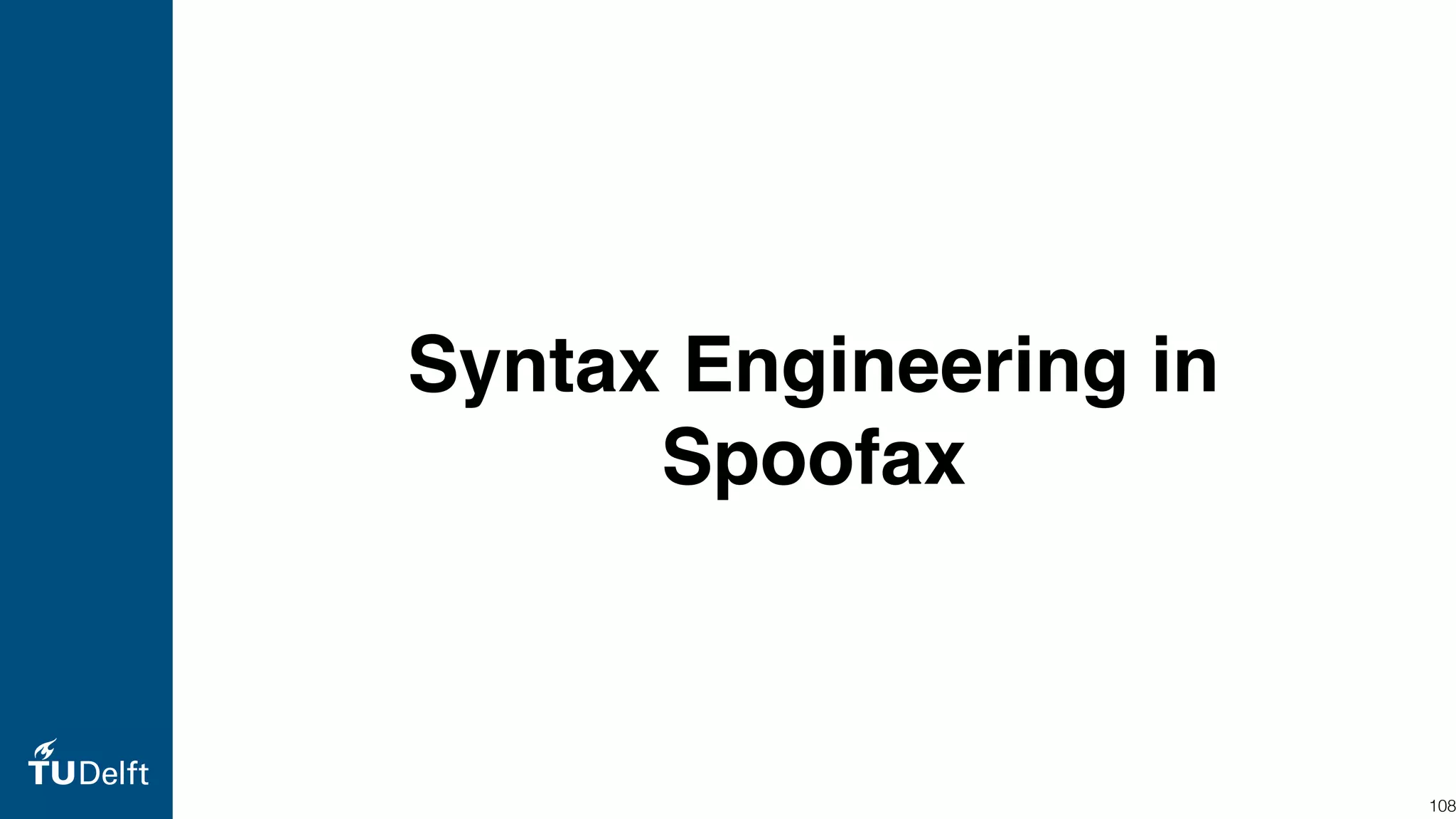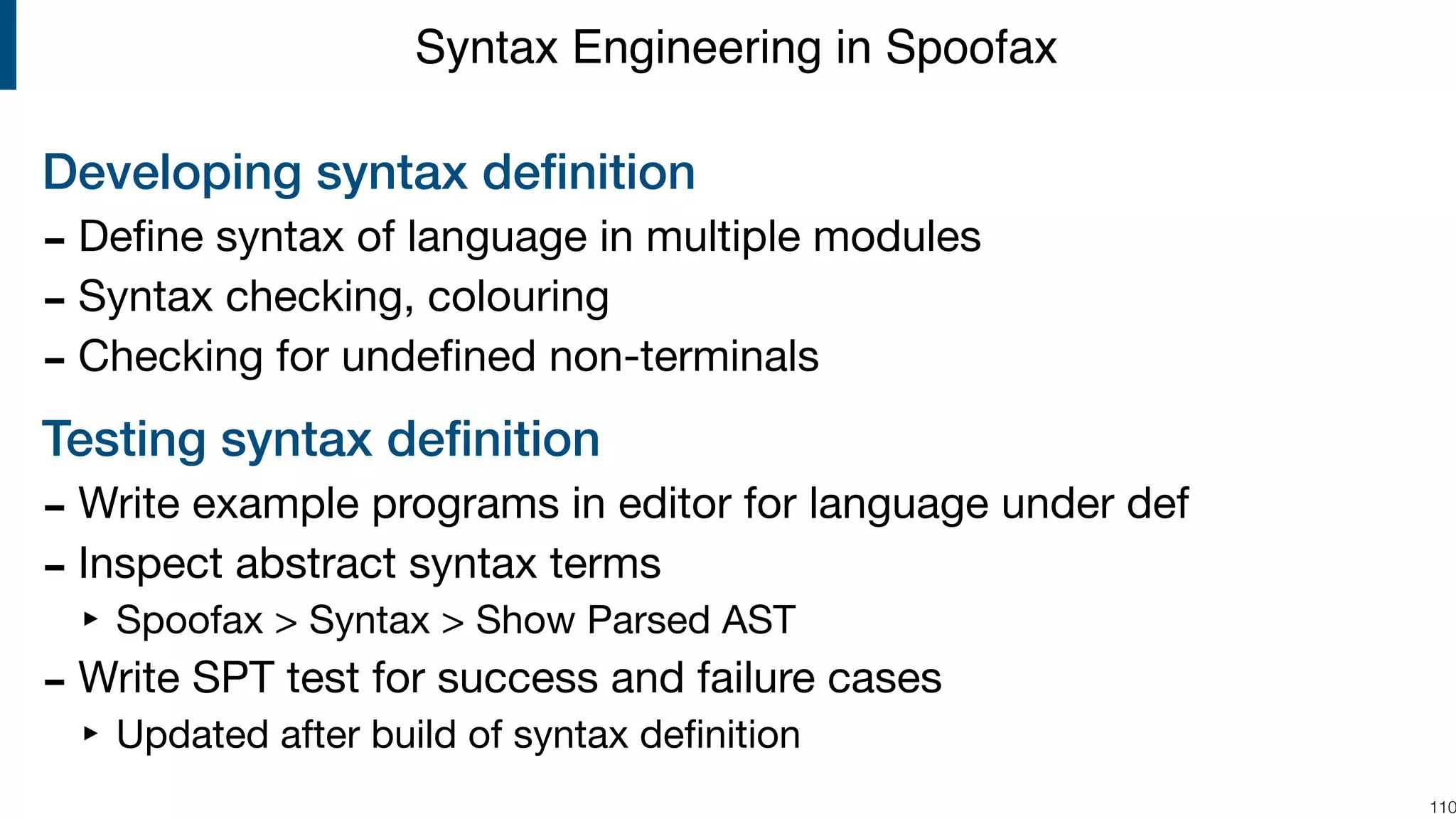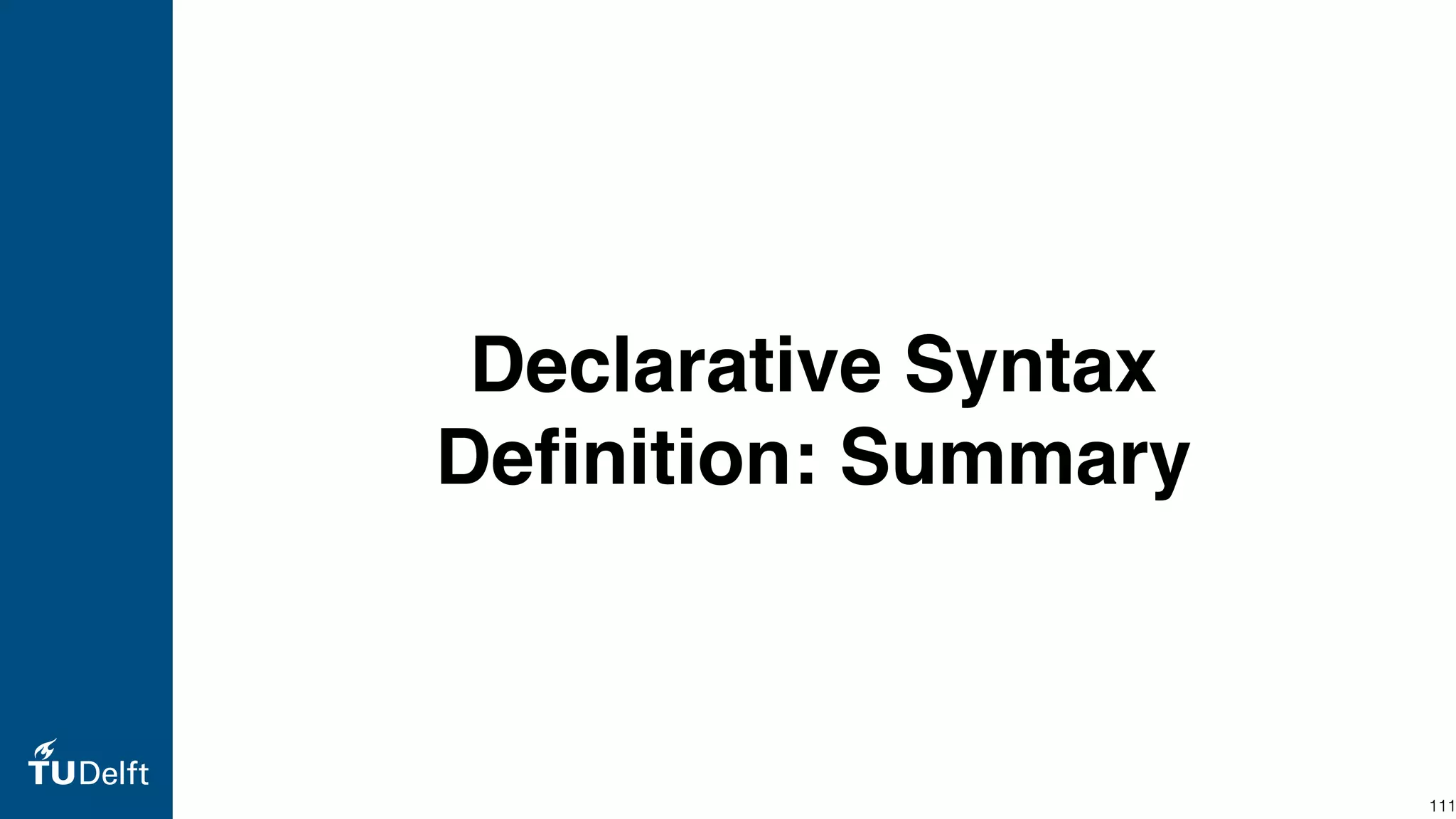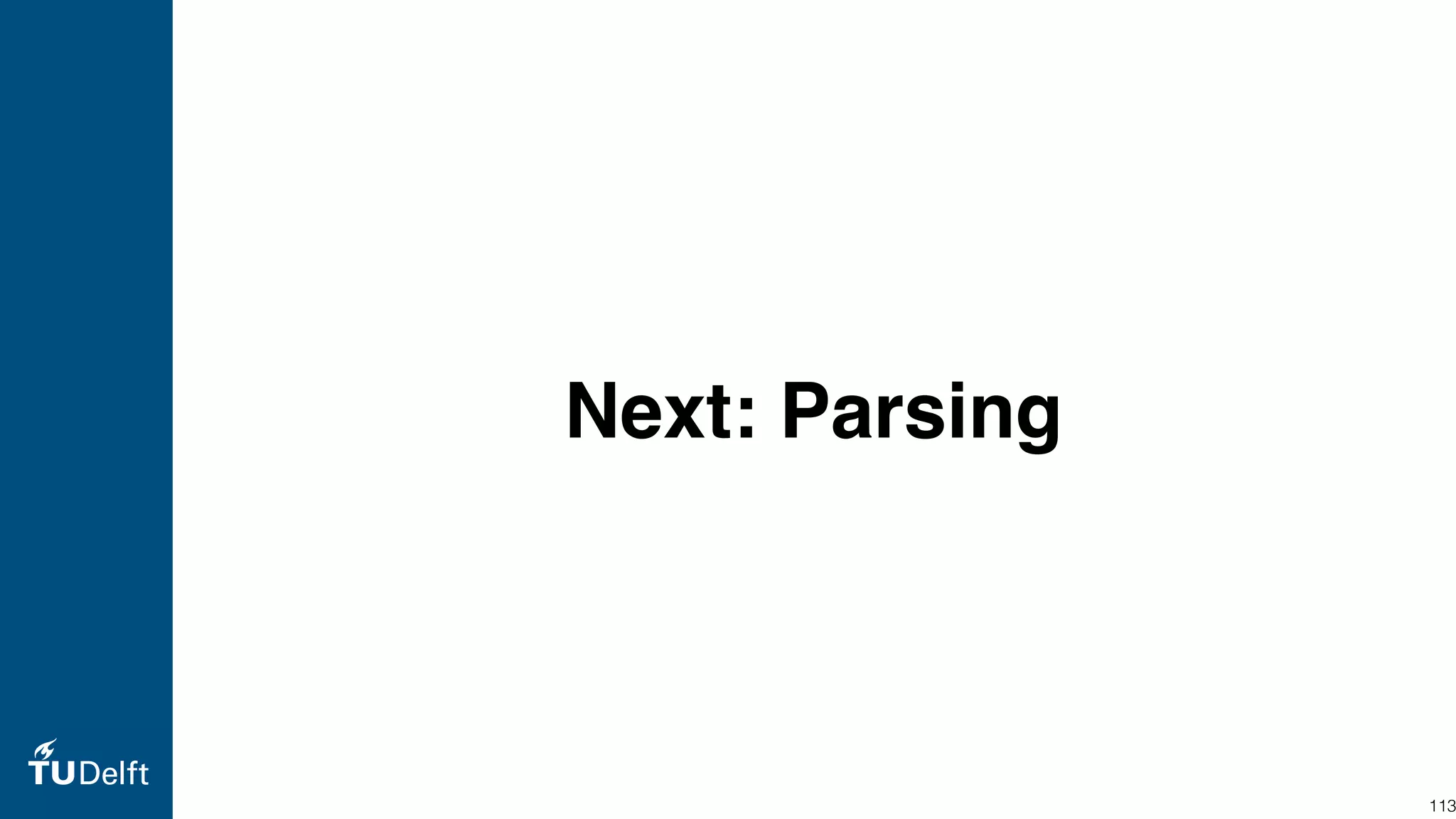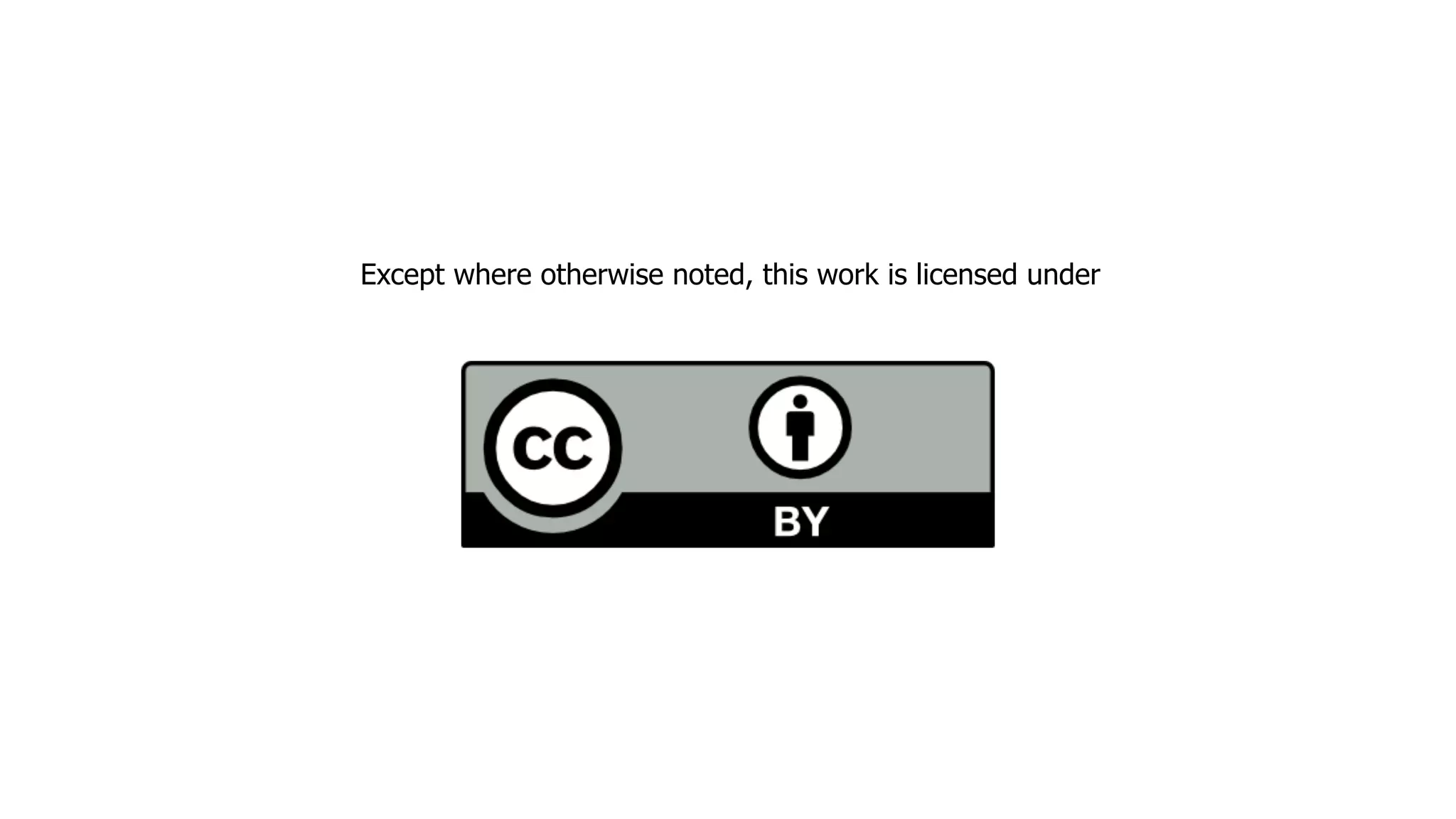The document describes a lecture on declarative syntax definition. It discusses the perspective on declarative syntax definition explained in an Onward! 2010 essay. It also mentions an OOPSLA 2011 paper that introduced the SPoofax Testing (SPT) language used in the section on testing syntax definitions. Finally, it provides a link to documentation on the SDF3 syntax definition formalism.
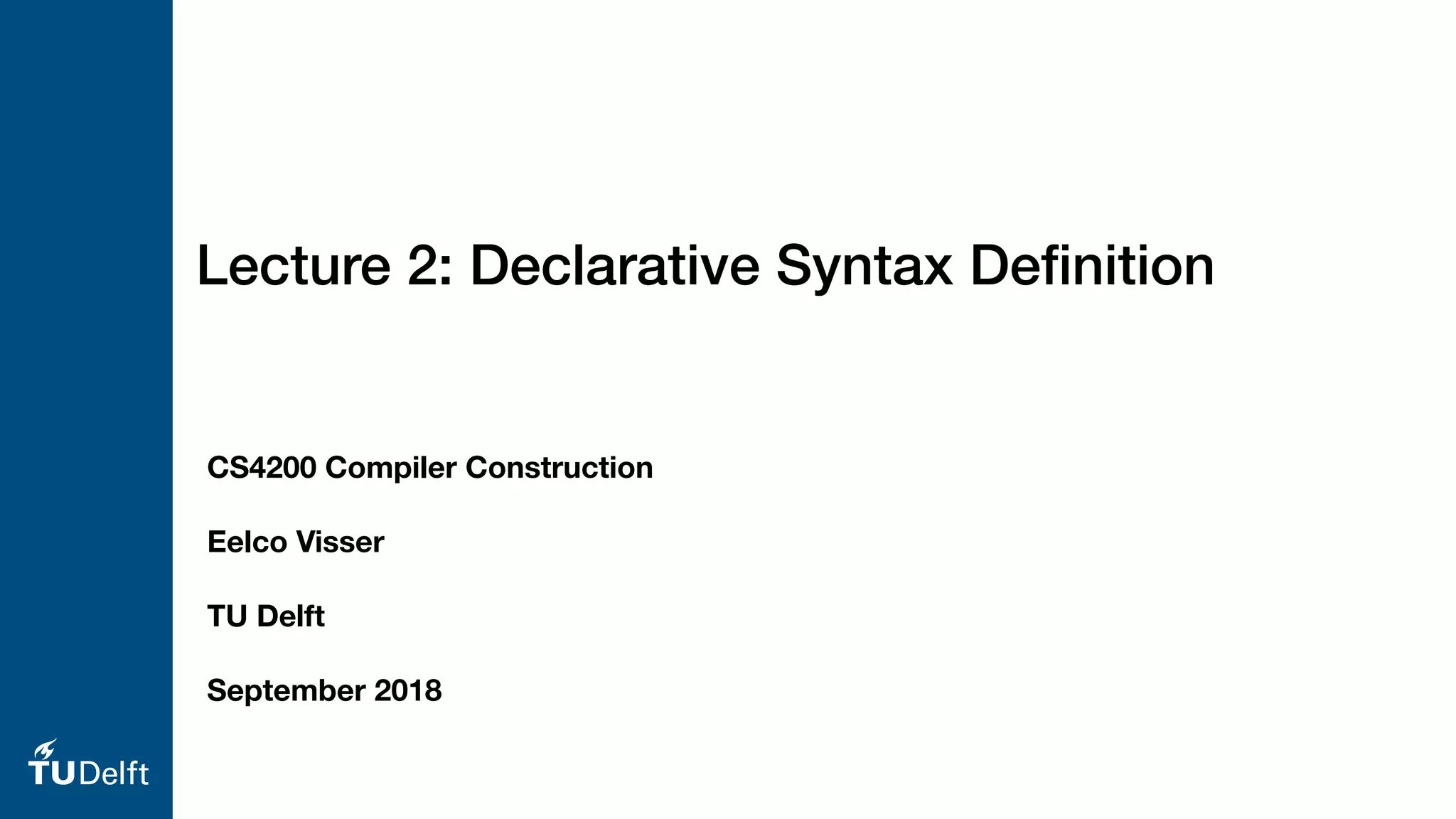


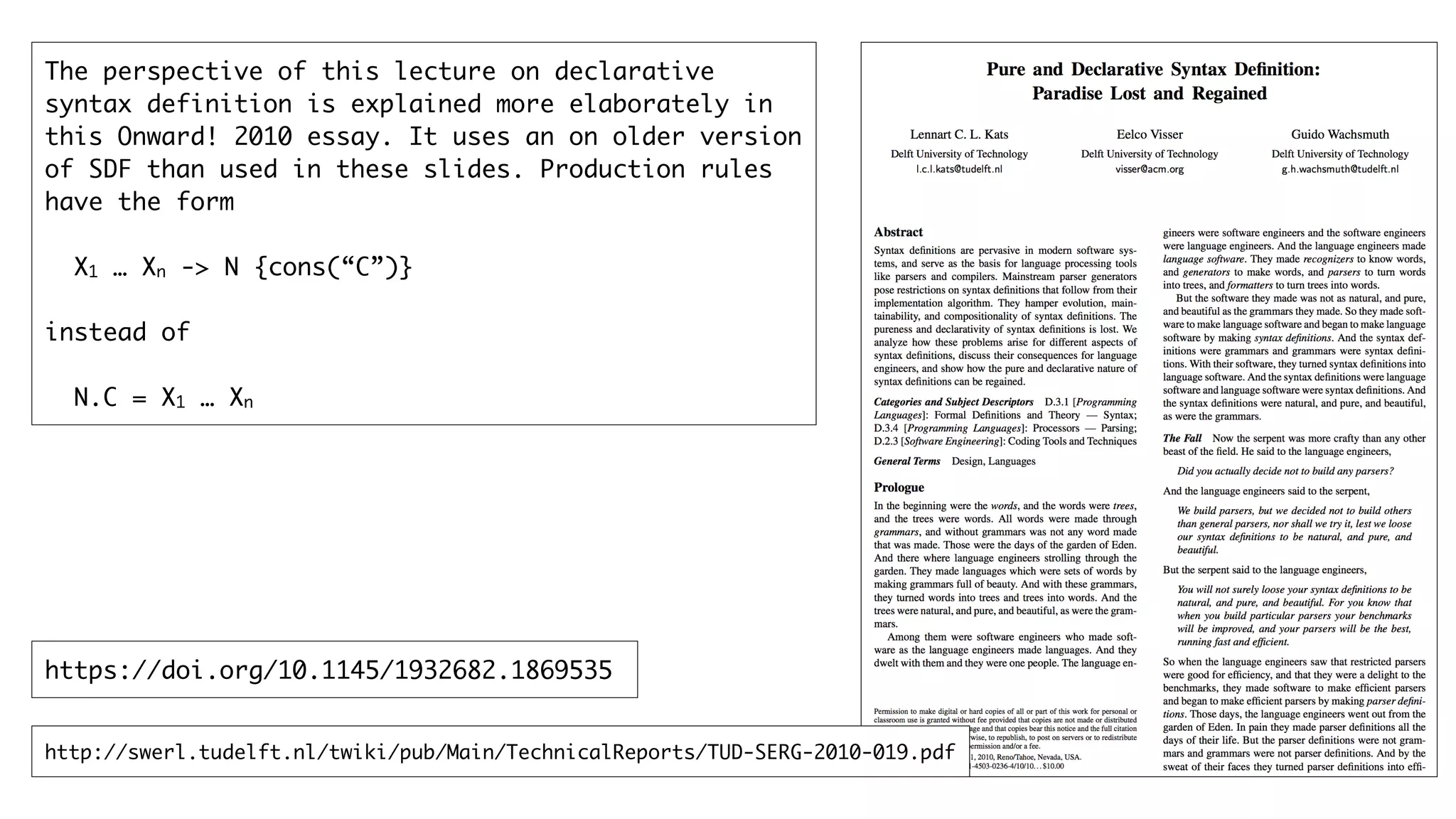
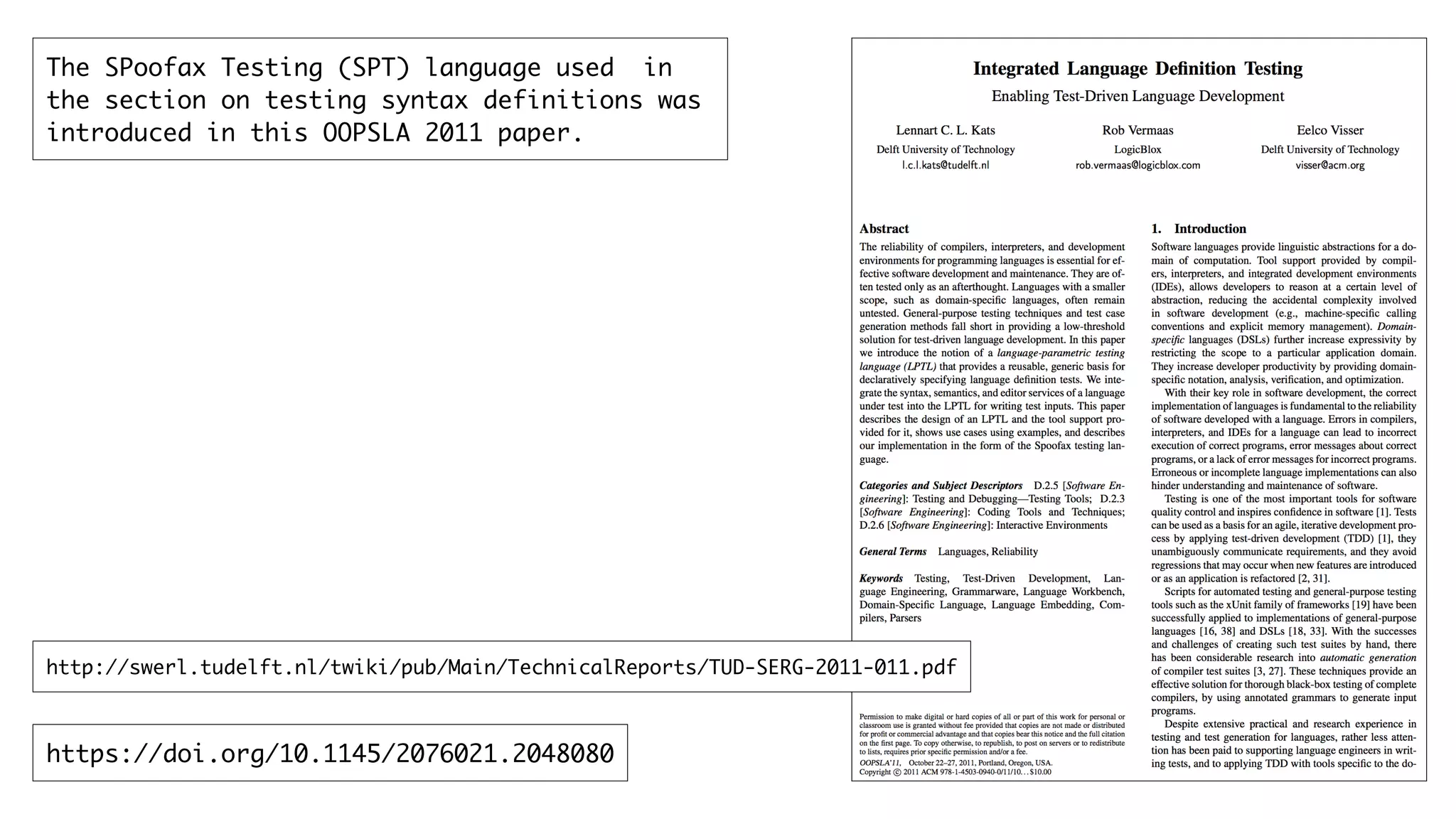
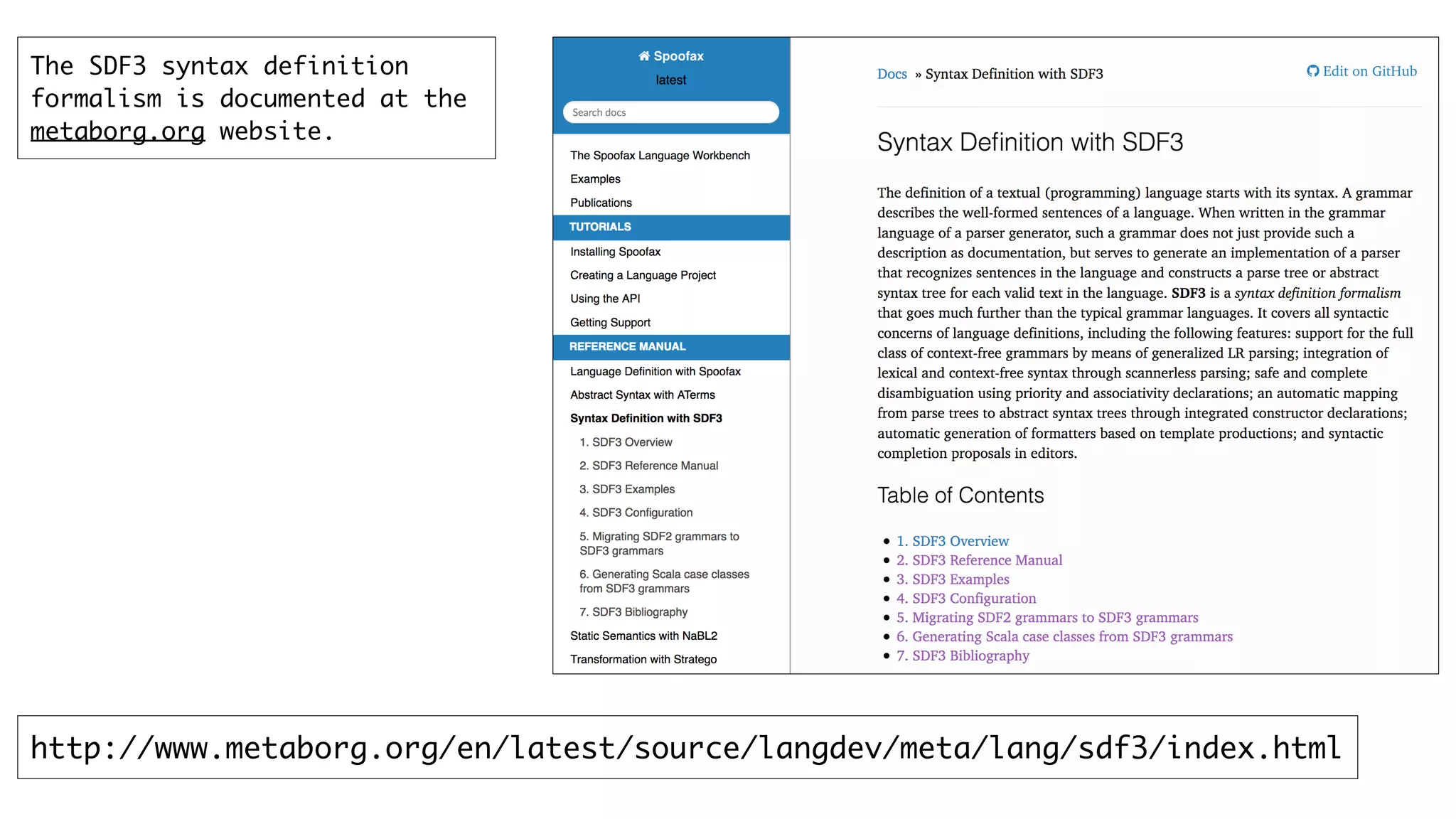
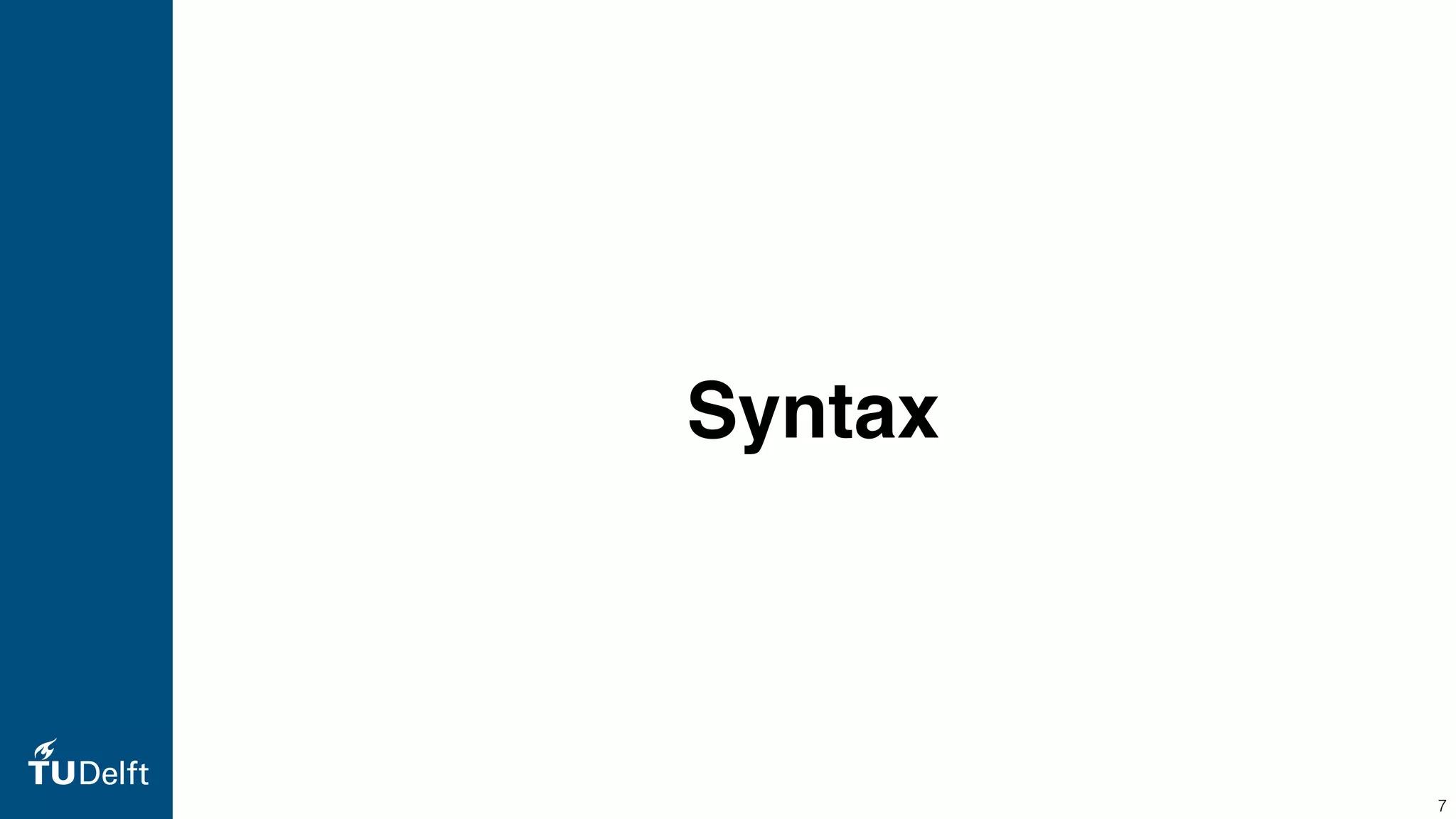
![What is Syntax? !8 https://en.wikipedia.org/wiki/Syntax In mathematics, syntax refers to the rules governing the behavior of mathematical systems, such as formal languages used in logic. (See logical syntax.) In linguistics, syntax (/ˈsɪntæks/[1][2]) is the set of rules, principles, and processes that govern the structure of sentences in a given language, specifically word order and punctuation. The term syntax is also used to refer to the study of such principles and processes.[3] The goal of many syntacticians is to discover the syntactic rules common to all languages. The word syntax comes from Ancient Greek: σύνταξις "coordination", which consists of σύν syn, "together," and τάξις táxis, "an ordering".](https://image.slidesharecdn.com/cs4200-2018-2-syntax-definition-180907135337/75/Compiler-Construction-Lecture-2-Declarative-Syntax-Definition-8-2048.jpg)
![Syntax (Programming Languages) !9 In computer science, the syntax of a computer language is the set of rules that defines the combinations of symbols that are considered to be a correctly structured document or fragment in that language. This applies both to programming languages, where the document represents source code, and markup languages, where the document represents data. The syntax of a language defines its surface form.[1] Text-based computer languages are based on sequences of characters, while visual programming languages are based on the spatial layout and connections between symbols (which may be textual or graphical). Documents that are syntactically invalid are said to have a syntax error. https://en.wikipedia.org/wiki/Syntax_(programming_languages)](https://image.slidesharecdn.com/cs4200-2018-2-syntax-definition-180907135337/75/Compiler-Construction-Lecture-2-Declarative-Syntax-Definition-9-2048.jpg)




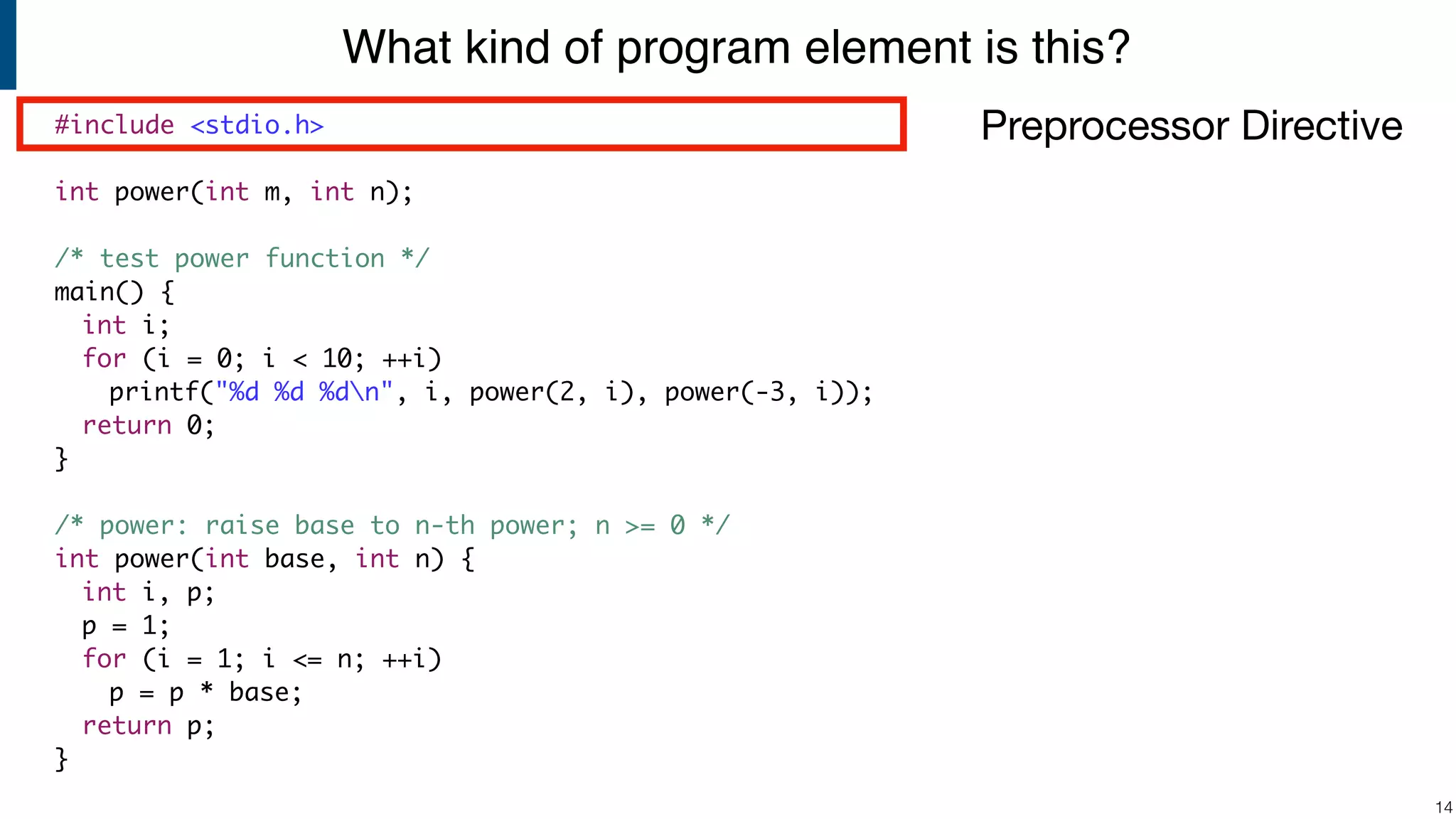
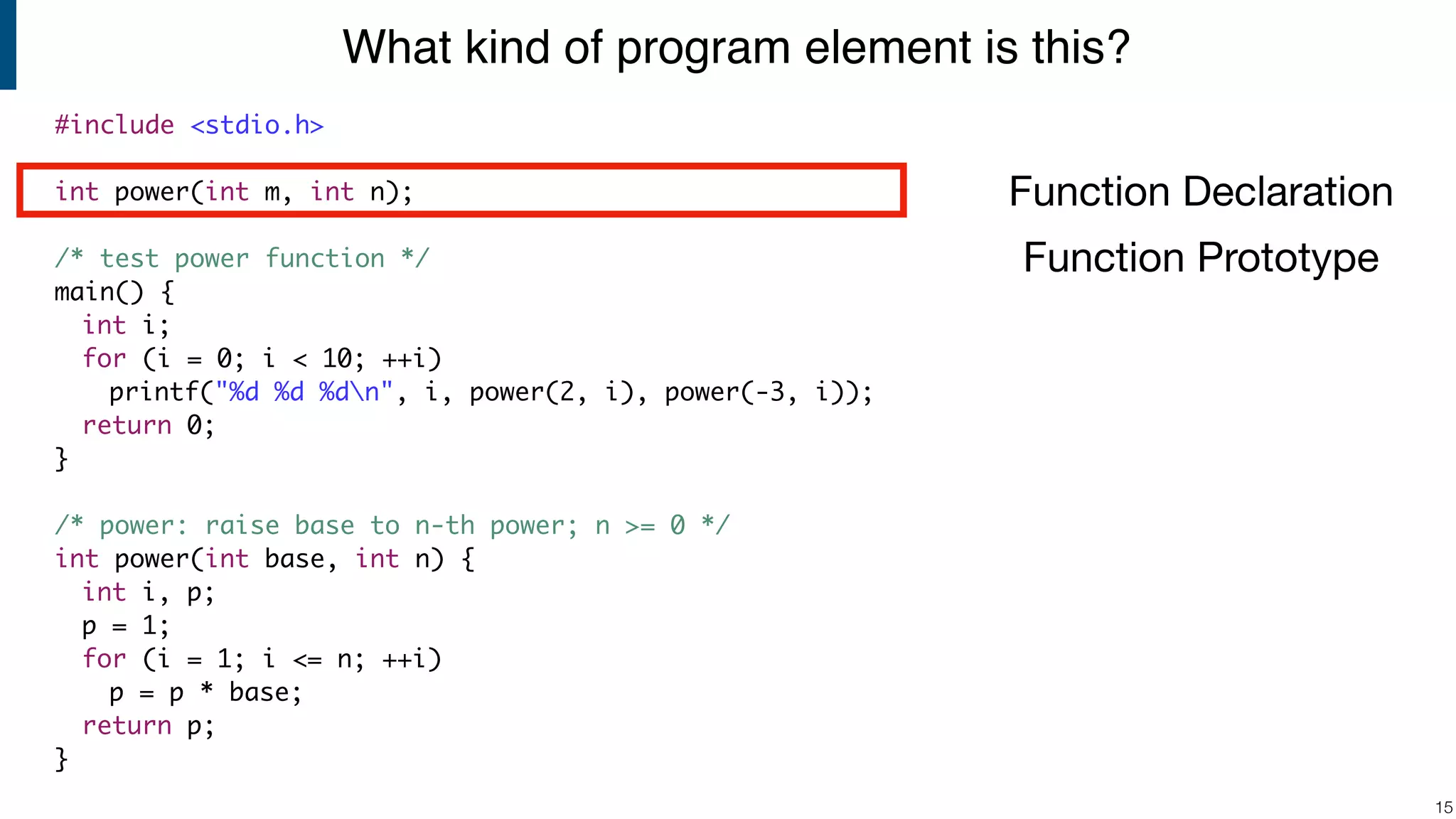

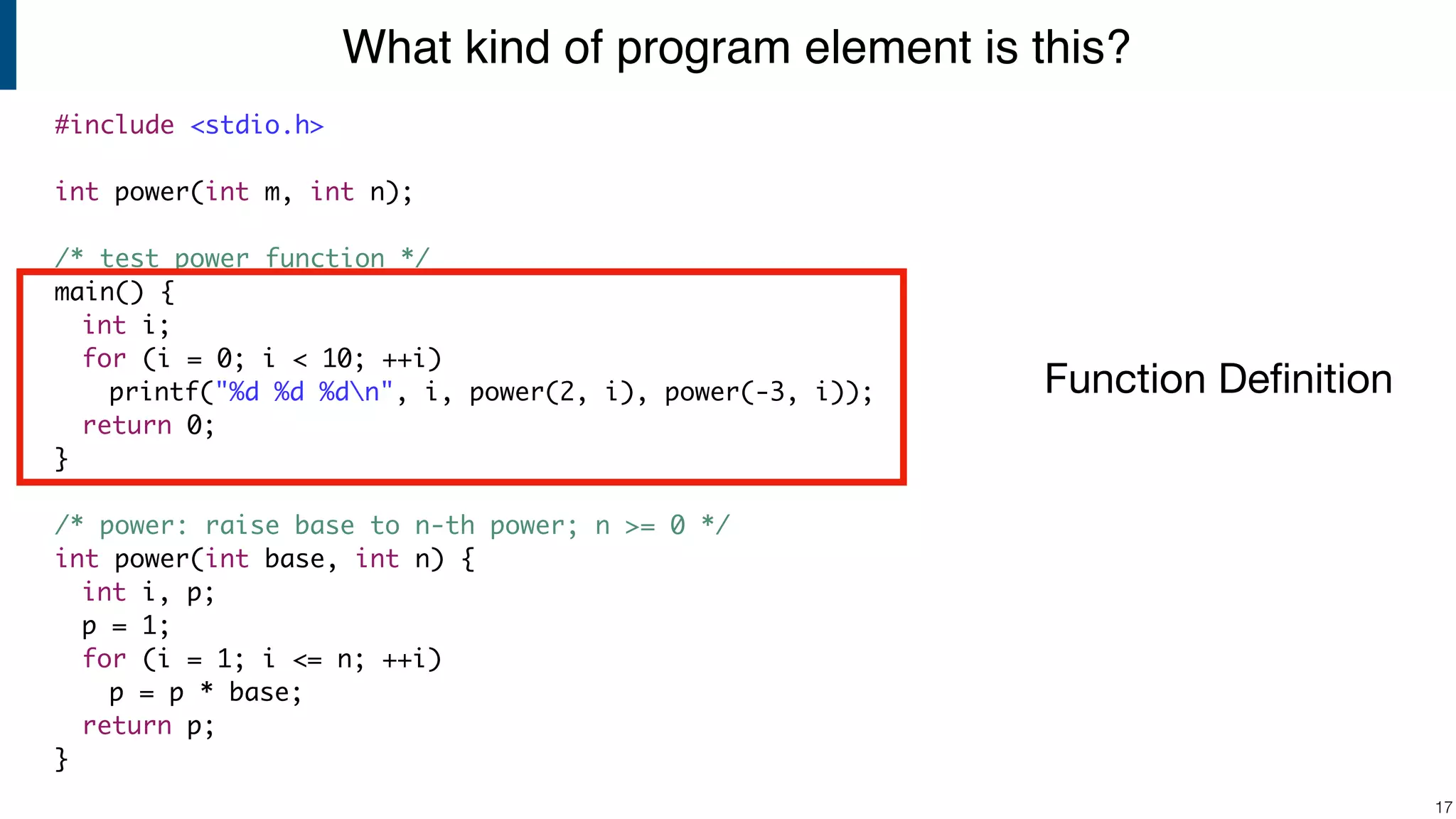

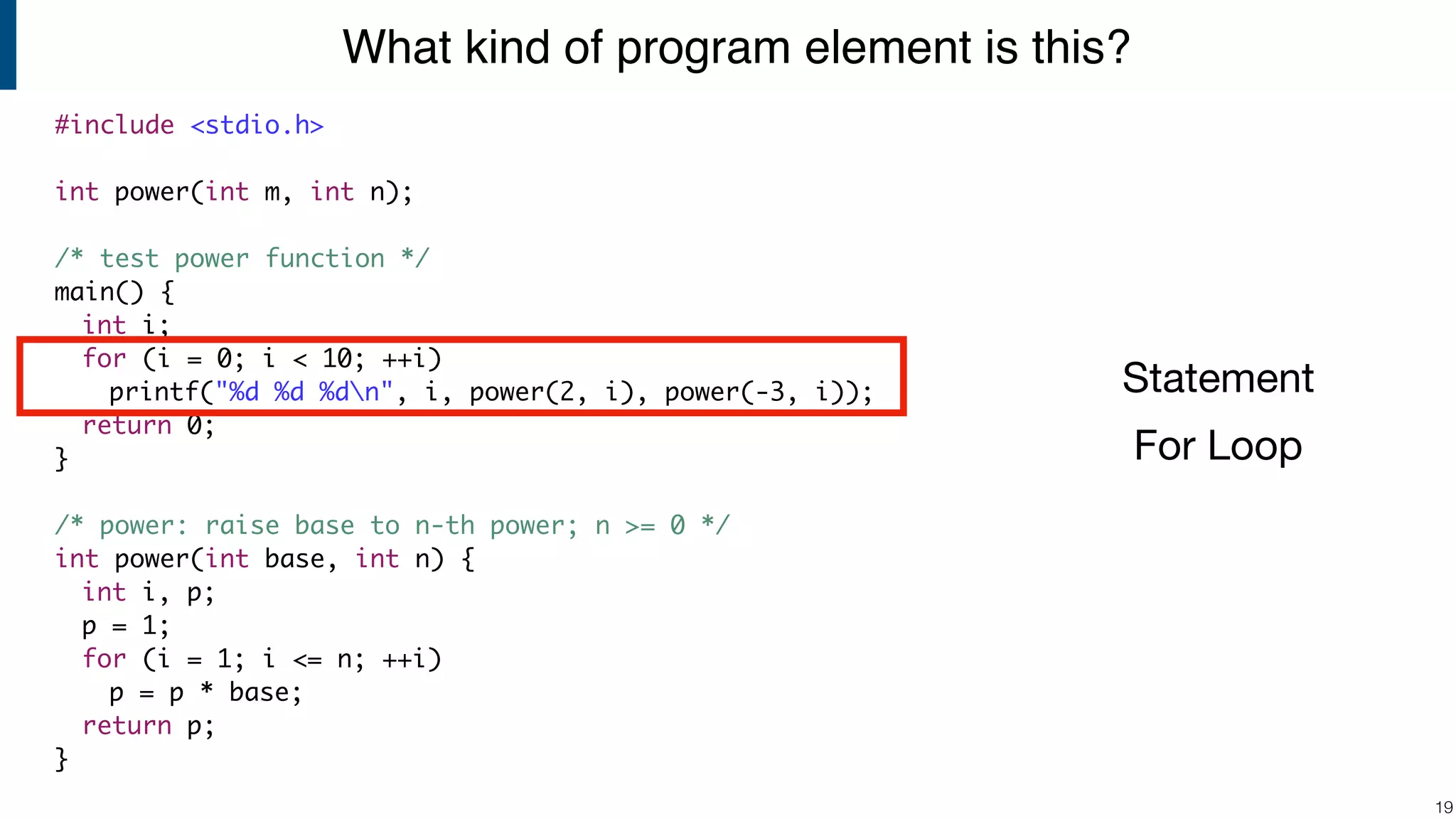
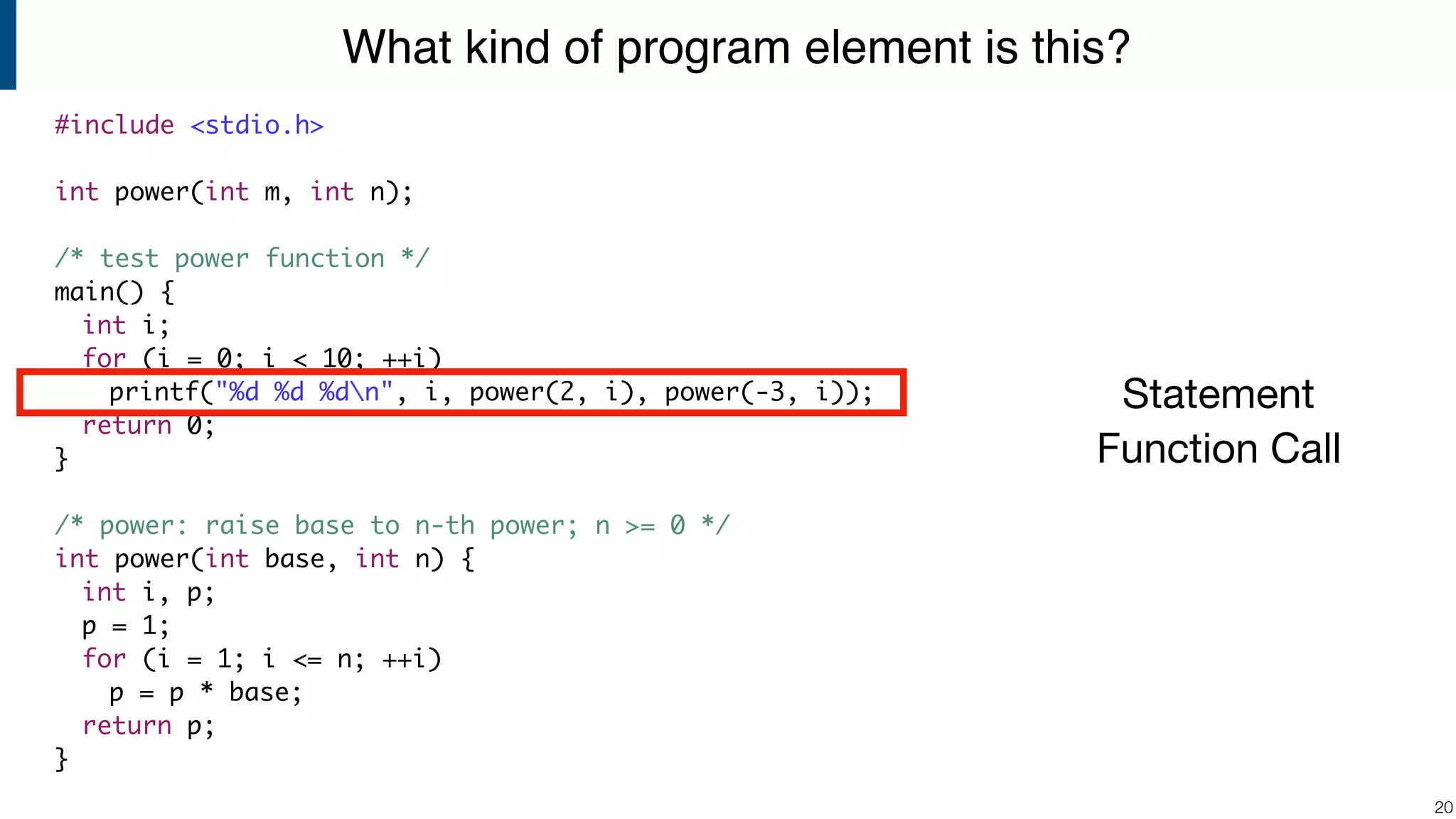
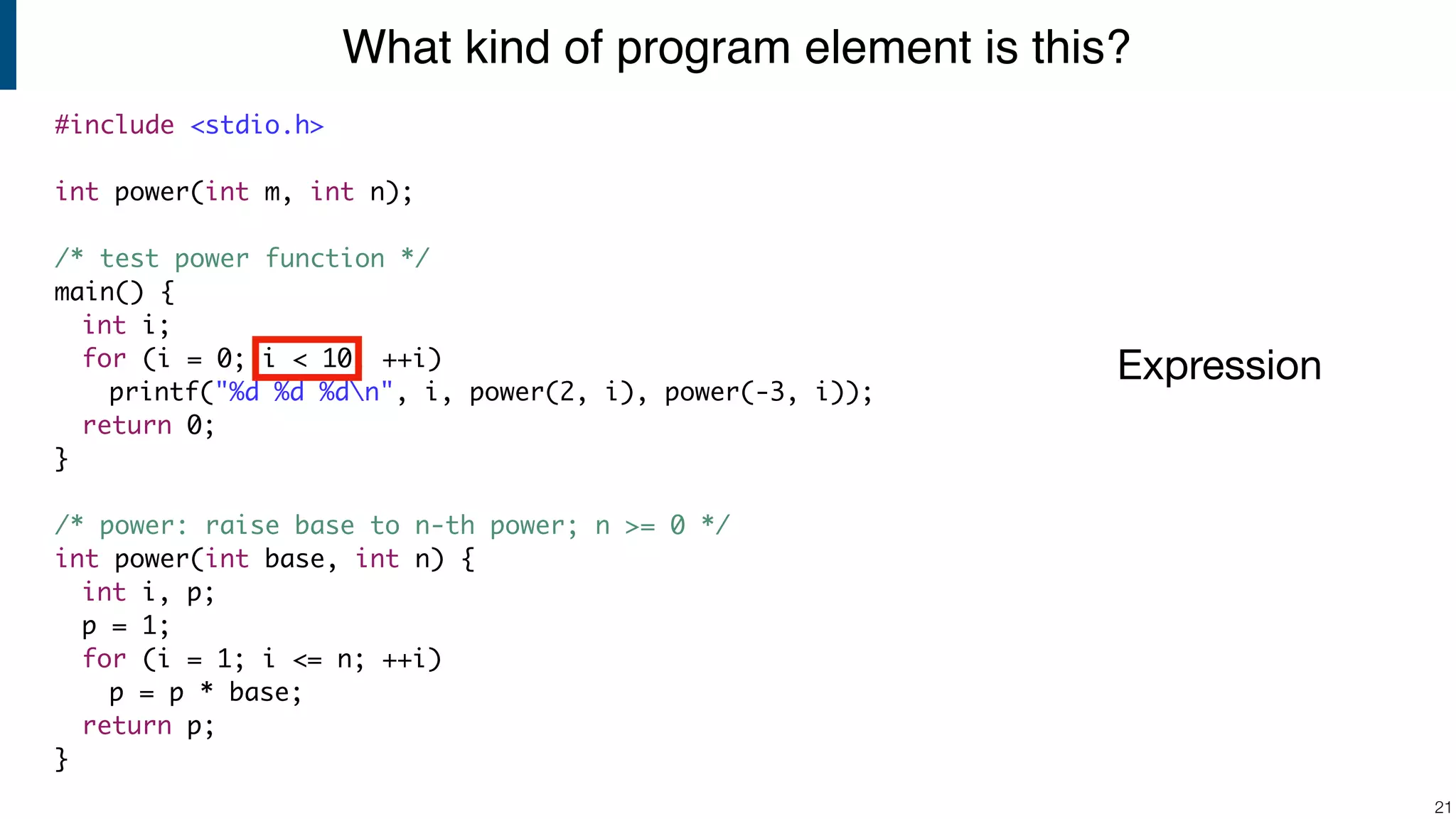
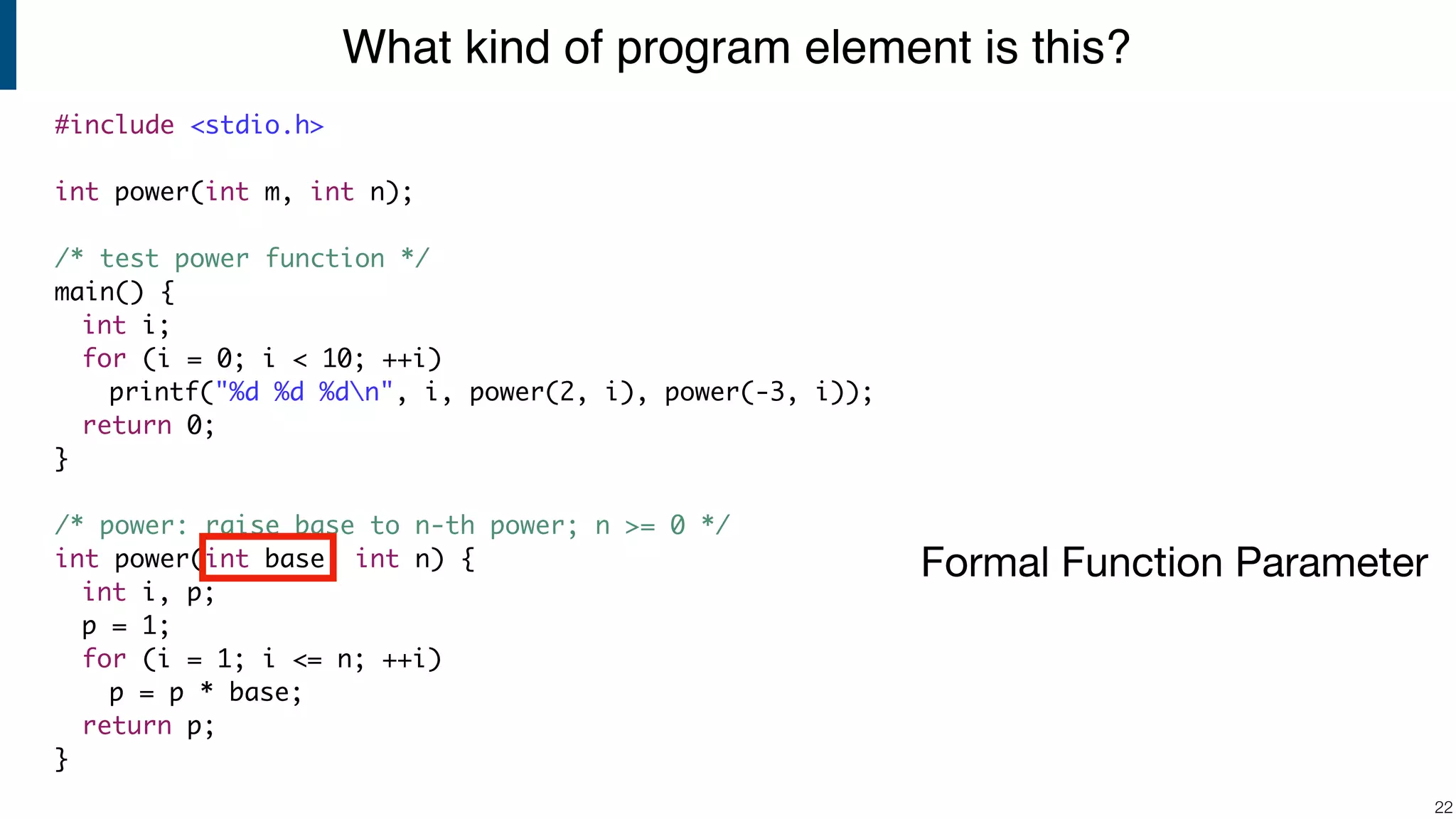
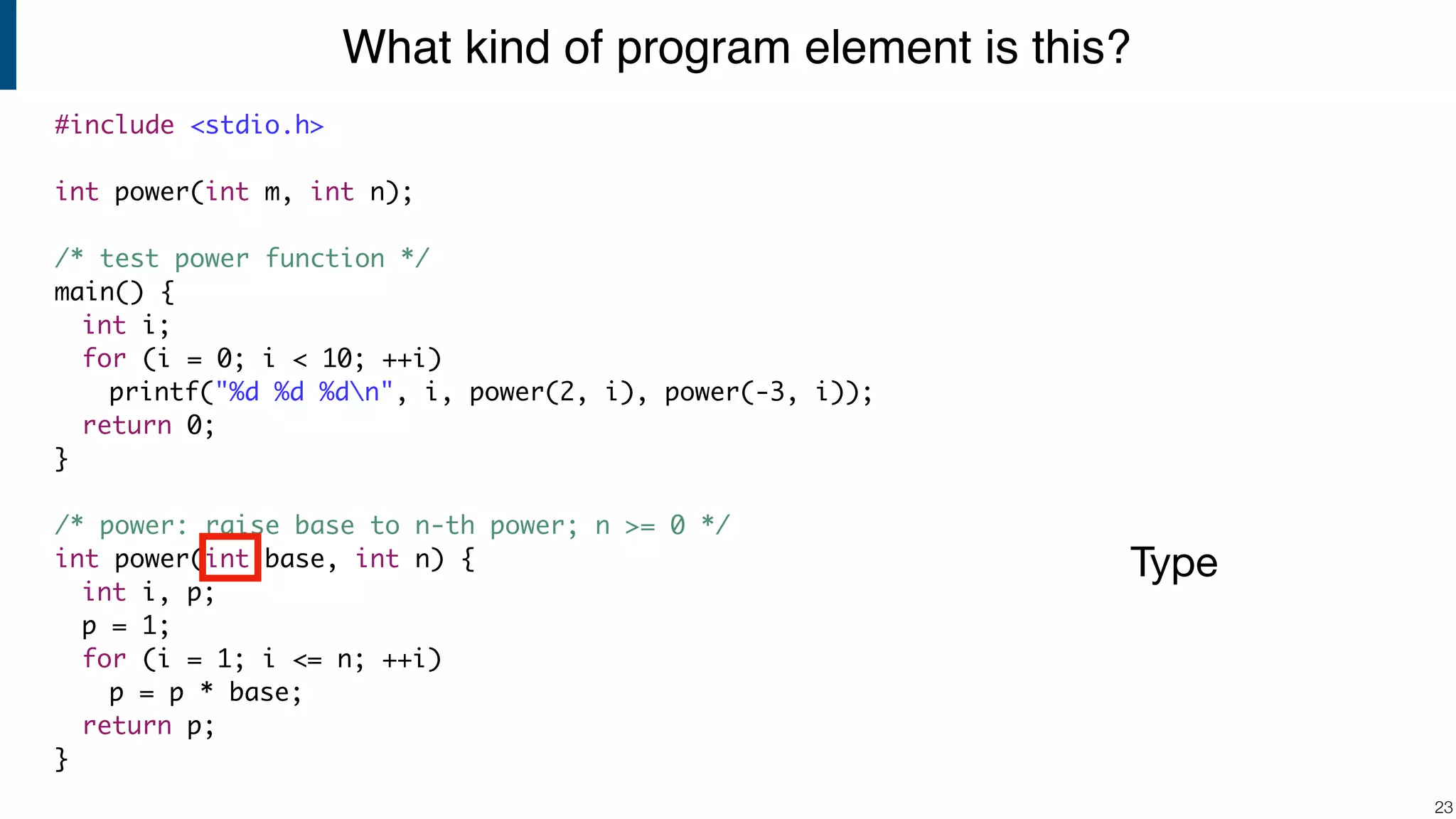
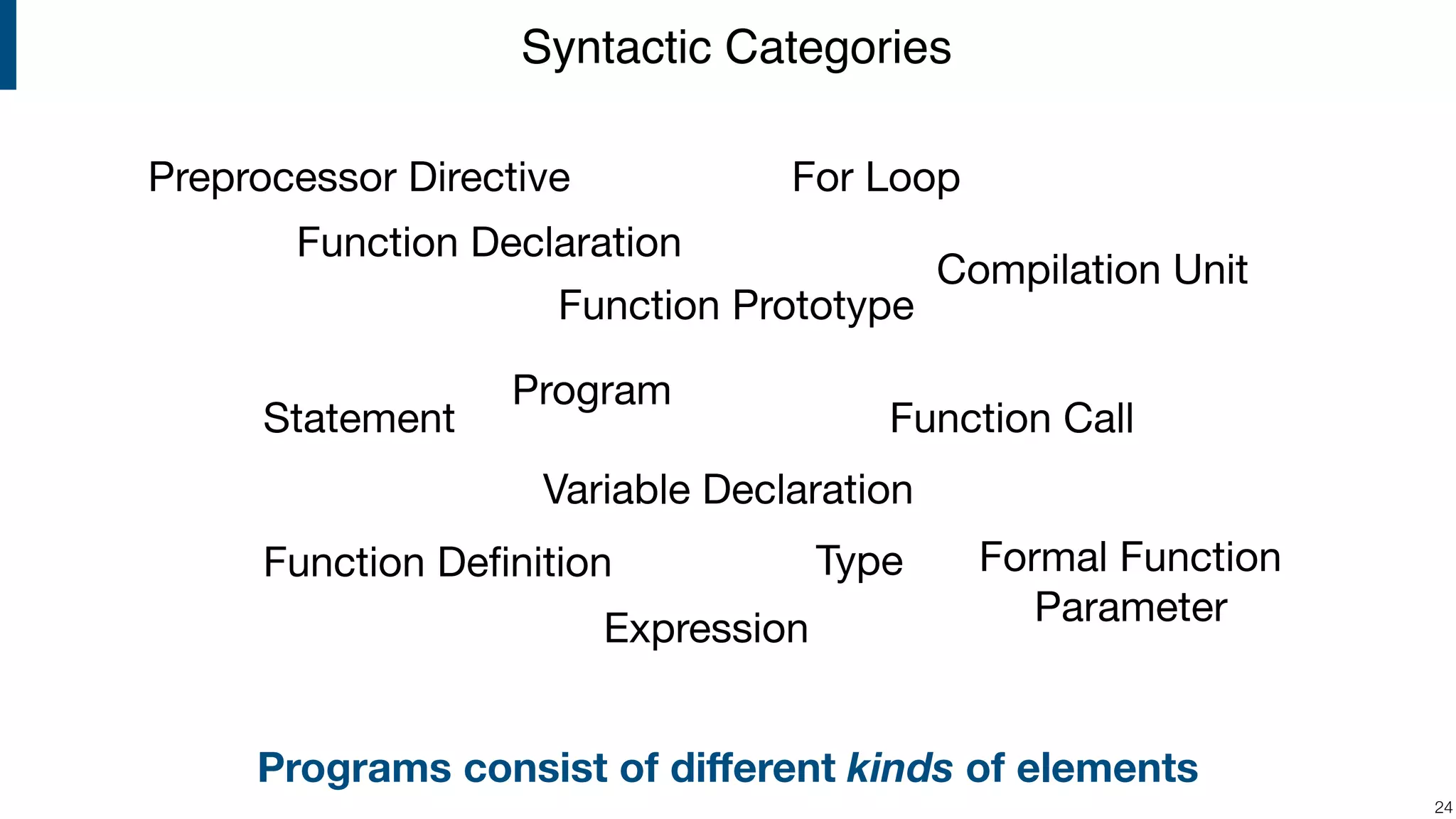
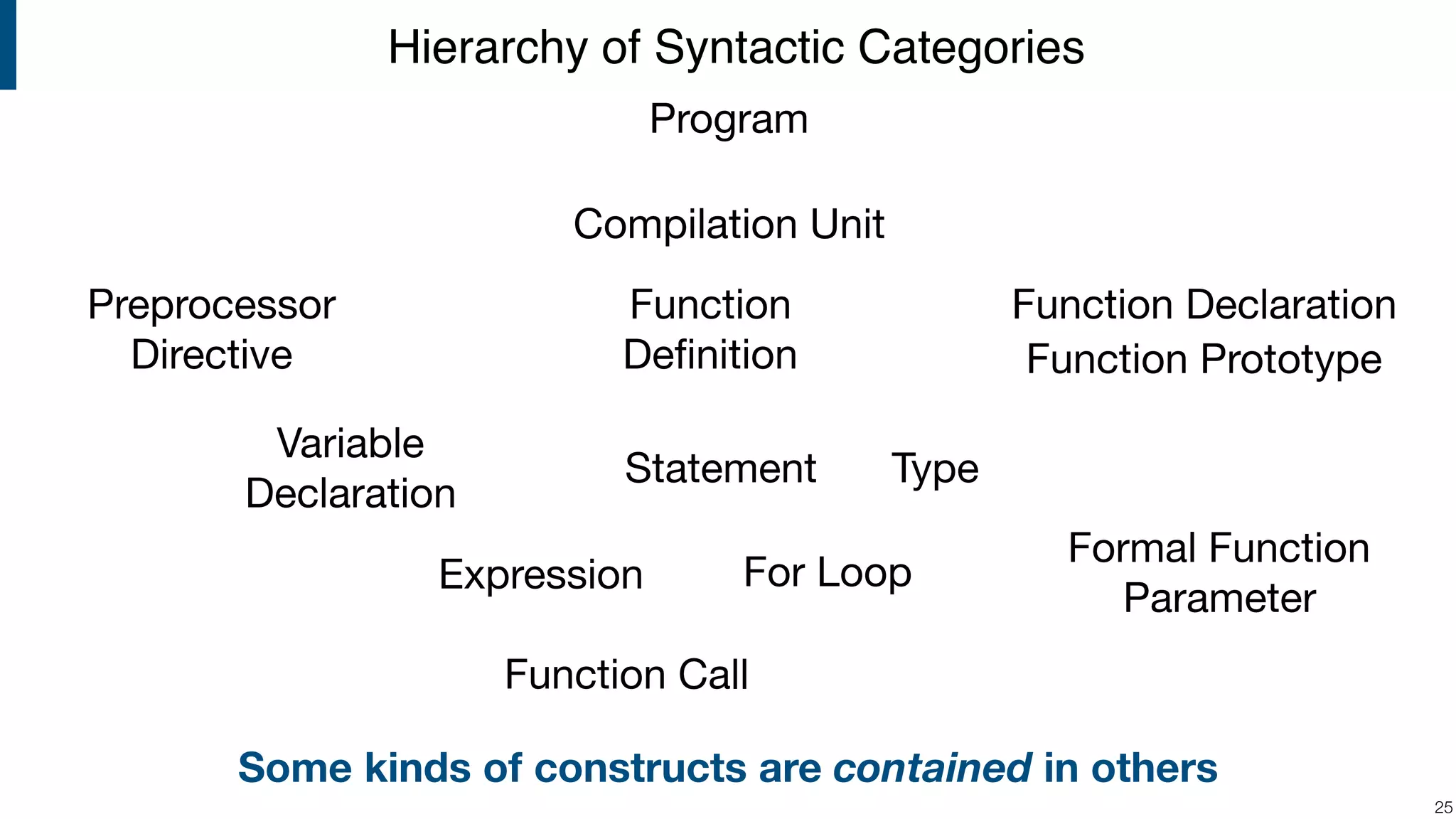

![!27 let var N := 8 type intArray = array of int var row := intArray[N] of 0 var col := intArray[N] of 0 var diag1 := intArray[N + N - 1] of 0 var diag2 := intArray[N + N - 1] of 0 function printboard() = ( for i := 0 to N - 1 do ( for j := 0 to N - 1 do print(if col[i] = j then " O" else " ."); print("n") ); print("n")) function try(c : int) = ( if c = N then printboard() else for r := 0 to N - 1 do if row[r] = 0 & diag1[r + c] = 0 & diag2[r + 7 - c] = 0 then ( row[r] := 1; diag1[r + c] := 1; diag2[r + 7 - c] := 1; col[c] := r; try(c + 1); row[r] := 0; diag1[r + c] := 0; diag2[r + 7 - c] := 0)) in try(0) end A Tiger program that solves the n-queens problem](https://image.slidesharecdn.com/cs4200-2018-2-syntax-definition-180907135337/75/Compiler-Construction-Lecture-2-Declarative-Syntax-Definition-27-2048.jpg)
![!28 let var N := 8 type intArray = array of int var diag2 := intArray[N + N - 1] of 0 function printboard() = ( for i := 0 to N - 1 do ( for j := 0 to N - 1 do print(if col[i] = j then " O" else " ."); print("n"))) function try(c : int) = ( if c = N then printboard() else for r := 0 to N - 1 do if row[r] = 0 & diag1[r + c] = 0 then ( diag2[r + 7 - c] := 1; try(c + 1);)) in try(0) end A mutilated n-queens Tiger program with ‘redundant’ elements removed What are the syntactic categories of Tiger? What are the language constructs of Tiger called?](https://image.slidesharecdn.com/cs4200-2018-2-syntax-definition-180907135337/75/Compiler-Construction-Lecture-2-Declarative-Syntax-Definition-28-2048.jpg)
![!29 let var N := 8 type intArray = array of int var diag2 := intArray[N + N - 1] of 0 function printboard() = ( for i := 0 to N - 1 do ( for j := 0 to N - 1 do print(if col[i] = j then " O" else " ."); print("n"))) function try(c : int) = ( if c = N then printboard() else for r := 0 to N - 1 do if row[r] = 0 & diag1[r + c] = 0 then ( diag2[r + 7 - c] := 1; try(c + 1);)) in try(0) end Program Expression Let Binding](https://image.slidesharecdn.com/cs4200-2018-2-syntax-definition-180907135337/75/Compiler-Construction-Lecture-2-Declarative-Syntax-Definition-29-2048.jpg)
![!30 let var N := 8 type intArray = array of int var diag2 := intArray[N + N - 1] of 0 function printboard() = ( for i := 0 to N - 1 do ( for j := 0 to N - 1 do print(if col[i] = j then " O" else " ."); print("n"))) function try(c : int) = ( if c = N then printboard() else for r := 0 to N - 1 do if row[r] = 0 & diag1[r + c] = 0 then ( diag2[r + 7 - c] := 1; try(c + 1);)) in try(0) end Variable Declaration](https://image.slidesharecdn.com/cs4200-2018-2-syntax-definition-180907135337/75/Compiler-Construction-Lecture-2-Declarative-Syntax-Definition-30-2048.jpg)
![!31 let var N := 8 type intArray = array of int var diag2 := intArray[N + N - 1] of 0 function printboard() = ( for i := 0 to N - 1 do ( for j := 0 to N - 1 do print(if col[i] = j then " O" else " ."); print("n"))) function try(c : int) = ( if c = N then printboard() else for r := 0 to N - 1 do if row[r] = 0 & diag1[r + c] = 0 then ( diag2[r + 7 - c] := 1; try(c + 1);)) in try(0) end Type Declaration](https://image.slidesharecdn.com/cs4200-2018-2-syntax-definition-180907135337/75/Compiler-Construction-Lecture-2-Declarative-Syntax-Definition-31-2048.jpg)
![!32 let var N := 8 type intArray = array of int var diag2 := intArray[N + N - 1] of 0 function printboard() = ( for i := 0 to N - 1 do ( for j := 0 to N - 1 do print(if col[i] = j then " O" else " ."); print("n"))) function try(c : int) = ( if c = N then printboard() else for r := 0 to N - 1 do if row[r] = 0 & diag1[r + c] = 0 then ( diag2[r + 7 - c] := 1; try(c + 1);)) in try(0) end Type Expression](https://image.slidesharecdn.com/cs4200-2018-2-syntax-definition-180907135337/75/Compiler-Construction-Lecture-2-Declarative-Syntax-Definition-32-2048.jpg)
![!33 let var N := 8 type intArray = array of int var diag2 := intArray[N + N - 1] of 0 function printboard() = ( for i := 0 to N - 1 do ( for j := 0 to N - 1 do print(if col[i] = j then " O" else " ."); print("n"))) function try(c : int) = ( if c = N then printboard() else for r := 0 to N - 1 do if row[r] = 0 & diag1[r + c] = 0 then ( diag2[r + 7 - c] := 1; try(c + 1);)) in try(0) end Expression Array Initialization](https://image.slidesharecdn.com/cs4200-2018-2-syntax-definition-180907135337/75/Compiler-Construction-Lecture-2-Declarative-Syntax-Definition-33-2048.jpg)
![!34 let var N := 8 type intArray = array of int var diag2 := intArray[N + N - 1] of 0 function printboard() = ( for i := 0 to N - 1 do ( for j := 0 to N - 1 do print(if col[i] = j then " O" else " ."); print("n"))) function try(c : int) = ( if c = N then printboard() else for r := 0 to N - 1 do if row[r] = 0 & diag1[r + c] = 0 then ( diag2[r + 7 - c] := 1; try(c + 1);)) in try(0) end Function Definition](https://image.slidesharecdn.com/cs4200-2018-2-syntax-definition-180907135337/75/Compiler-Construction-Lecture-2-Declarative-Syntax-Definition-34-2048.jpg)
![!35 let var N := 8 type intArray = array of int var diag2 := intArray[N + N - 1] of 0 function printboard() = ( for i := 0 to N - 1 do ( for j := 0 to N - 1 do print(if col[i] = j then " O" else " ."); print("n"))) function try(c : int) = ( if c = N then printboard() else for r := 0 to N - 1 do if row[r] = 0 & diag1[r + c] = 0 then ( diag2[r + 7 - c] := 1; try(c + 1);)) in try(0) end Function Name](https://image.slidesharecdn.com/cs4200-2018-2-syntax-definition-180907135337/75/Compiler-Construction-Lecture-2-Declarative-Syntax-Definition-35-2048.jpg)
![!36 let var N := 8 type intArray = array of int var diag2 := intArray[N + N - 1] of 0 function printboard() = ( for i := 0 to N - 1 do ( for j := 0 to N - 1 do print(if col[i] = j then " O" else " ."); print("n"))) function try(c : int) = ( if c = N then printboard() else for r := 0 to N - 1 do if row[r] = 0 & diag1[r + c] = 0 then ( diag2[r + 7 - c] := 1; try(c + 1);)) in try(0) end Function Body Expression For Loop](https://image.slidesharecdn.com/cs4200-2018-2-syntax-definition-180907135337/75/Compiler-Construction-Lecture-2-Declarative-Syntax-Definition-36-2048.jpg)
![!37 let var N := 8 type intArray = array of int var diag2 := intArray[N + N - 1] of 0 function printboard() = ( for i := 0 to N - 1 do ( for j := 0 to N - 1 do print(if col[i] = j then " O" else " ."); print("n"))) function try(c : int) = ( if c = N then printboard() else for r := 0 to N - 1 do if row[r] = 0 & diag1[r + c] = 0 then ( diag2[r + 7 - c] := 1; try(c + 1);)) in try(0) end Expression Sequential Composition](https://image.slidesharecdn.com/cs4200-2018-2-syntax-definition-180907135337/75/Compiler-Construction-Lecture-2-Declarative-Syntax-Definition-37-2048.jpg)
![!38 let var N := 8 type intArray = array of int var diag2 := intArray[N + N - 1] of 0 function printboard() = ( for i := 0 to N - 1 do ( for j := 0 to N - 1 do print(if col[i] = j then " O" else " ."); print("n"))) function try(c : int) = ( if c = N then printboard() else for r := 0 to N - 1 do if row[r] = 0 & diag1[r + c] = 0 then ( diag2[r + 7 - c] := 1; try(c + 1);)) in try(0) end Formal Parameter](https://image.slidesharecdn.com/cs4200-2018-2-syntax-definition-180907135337/75/Compiler-Construction-Lecture-2-Declarative-Syntax-Definition-38-2048.jpg)
![!39 let var N := 8 type intArray = array of int var diag2 := intArray[N + N - 1] of 0 function printboard() = ( for i := 0 to N - 1 do ( for j := 0 to N - 1 do print(if col[i] = j then " O" else " ."); print("n"))) function try(c : int) = ( if c = N then printboard() else for r := 0 to N - 1 do if row[r] = 0 & diag1[r + c] = 0 then ( diag2[r + 7 - c] := 1; try(c + 1);)) in try(0) end Expression Assignment](https://image.slidesharecdn.com/cs4200-2018-2-syntax-definition-180907135337/75/Compiler-Construction-Lecture-2-Declarative-Syntax-Definition-39-2048.jpg)
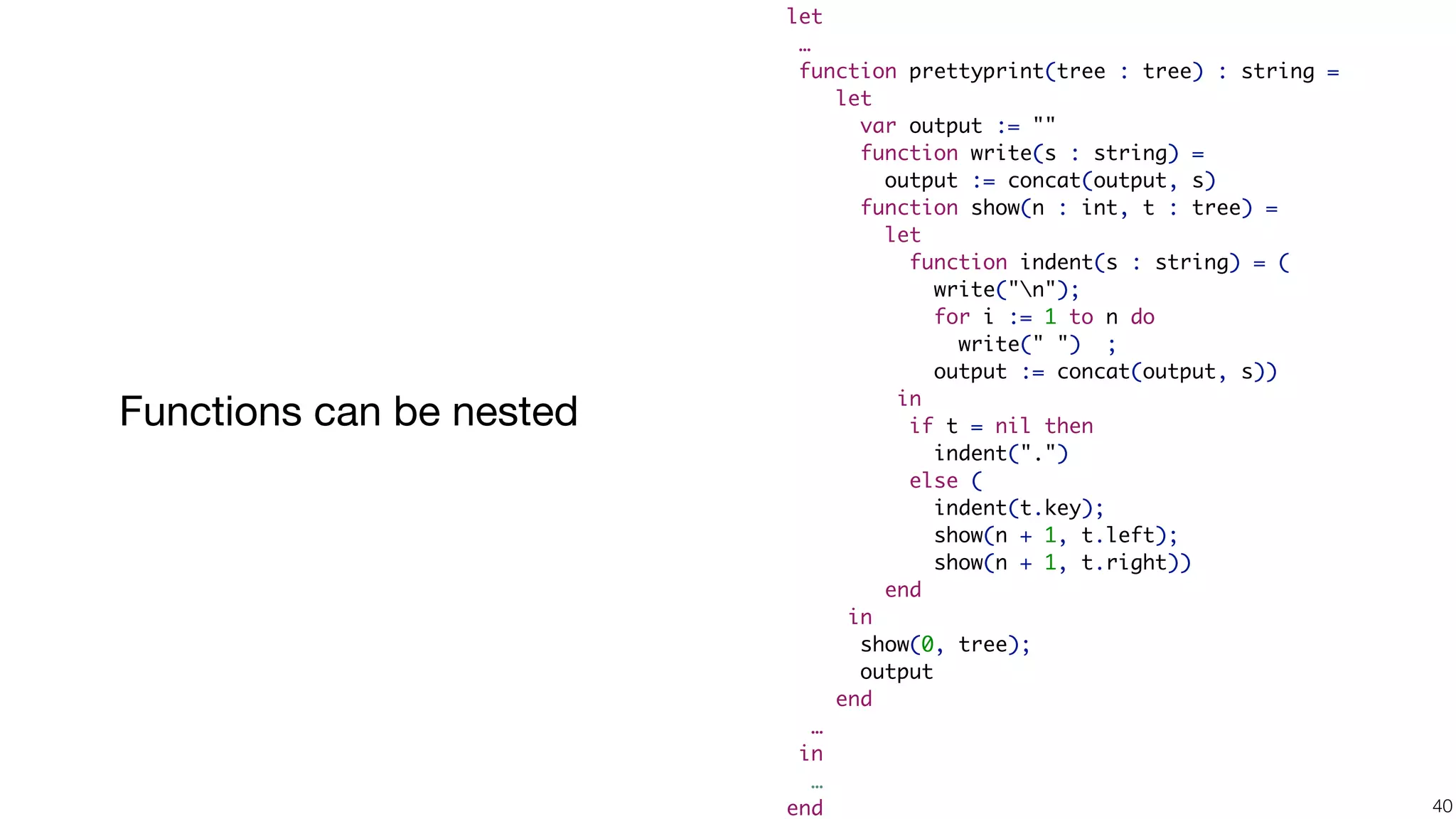
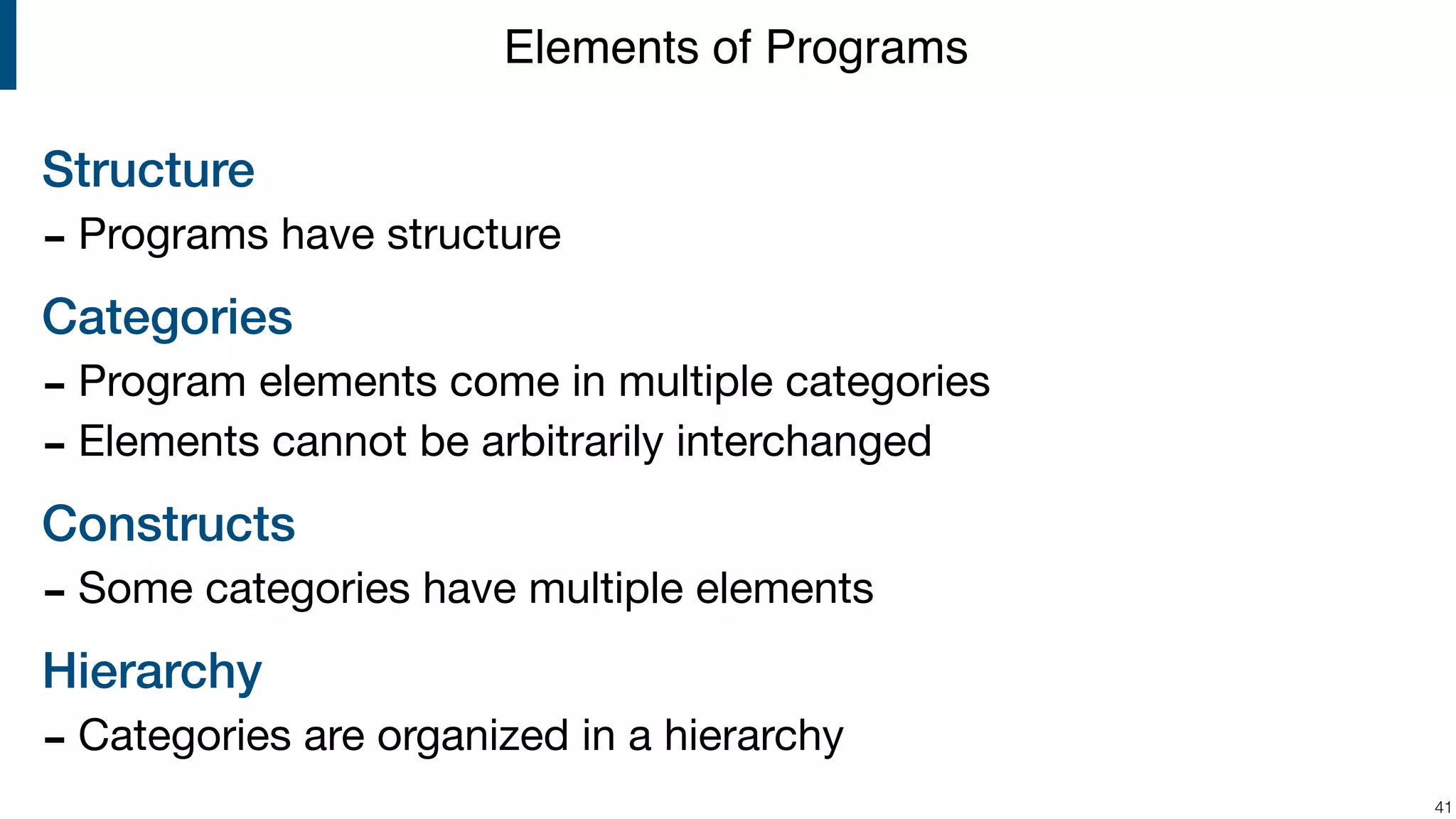
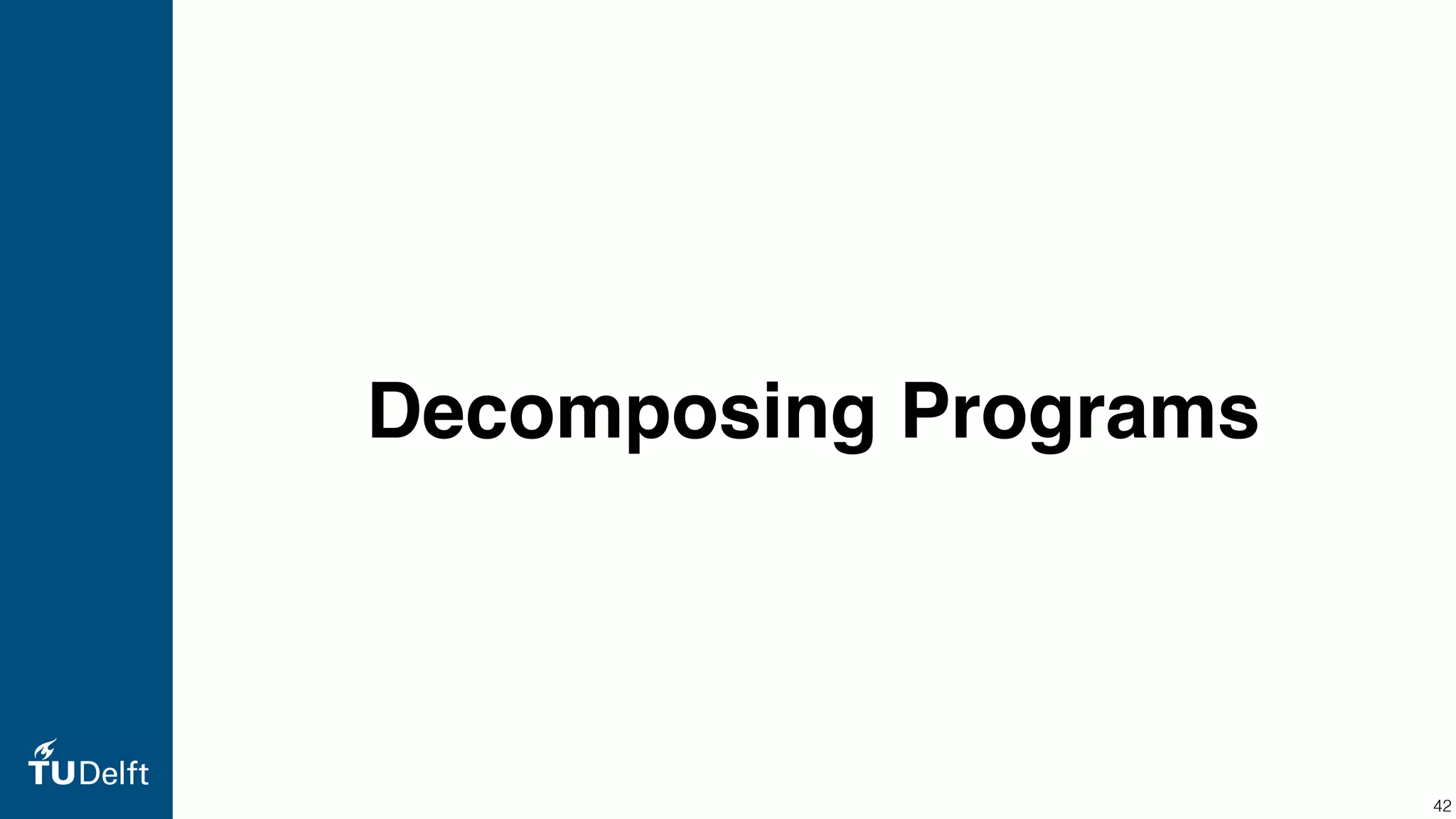

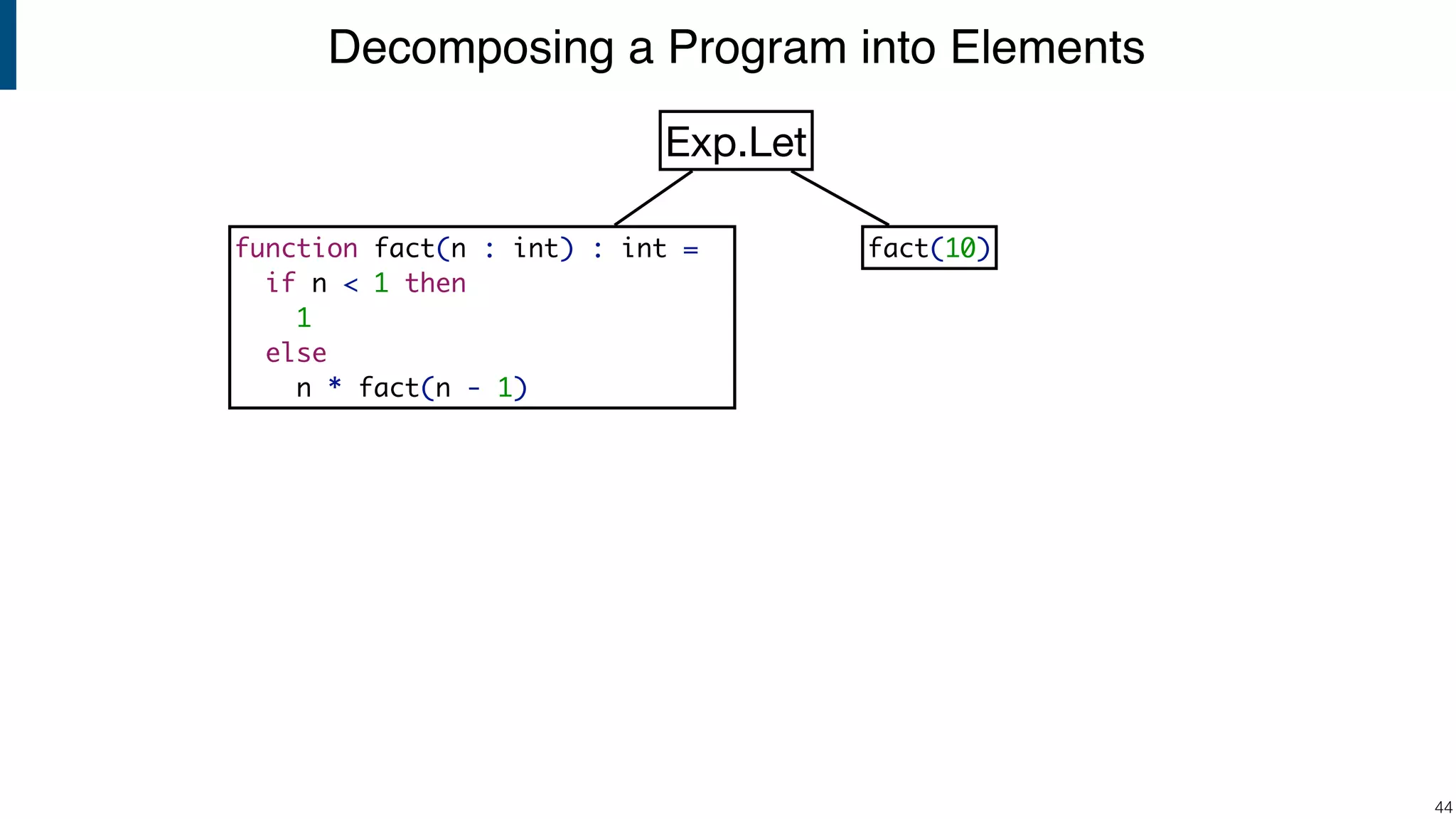

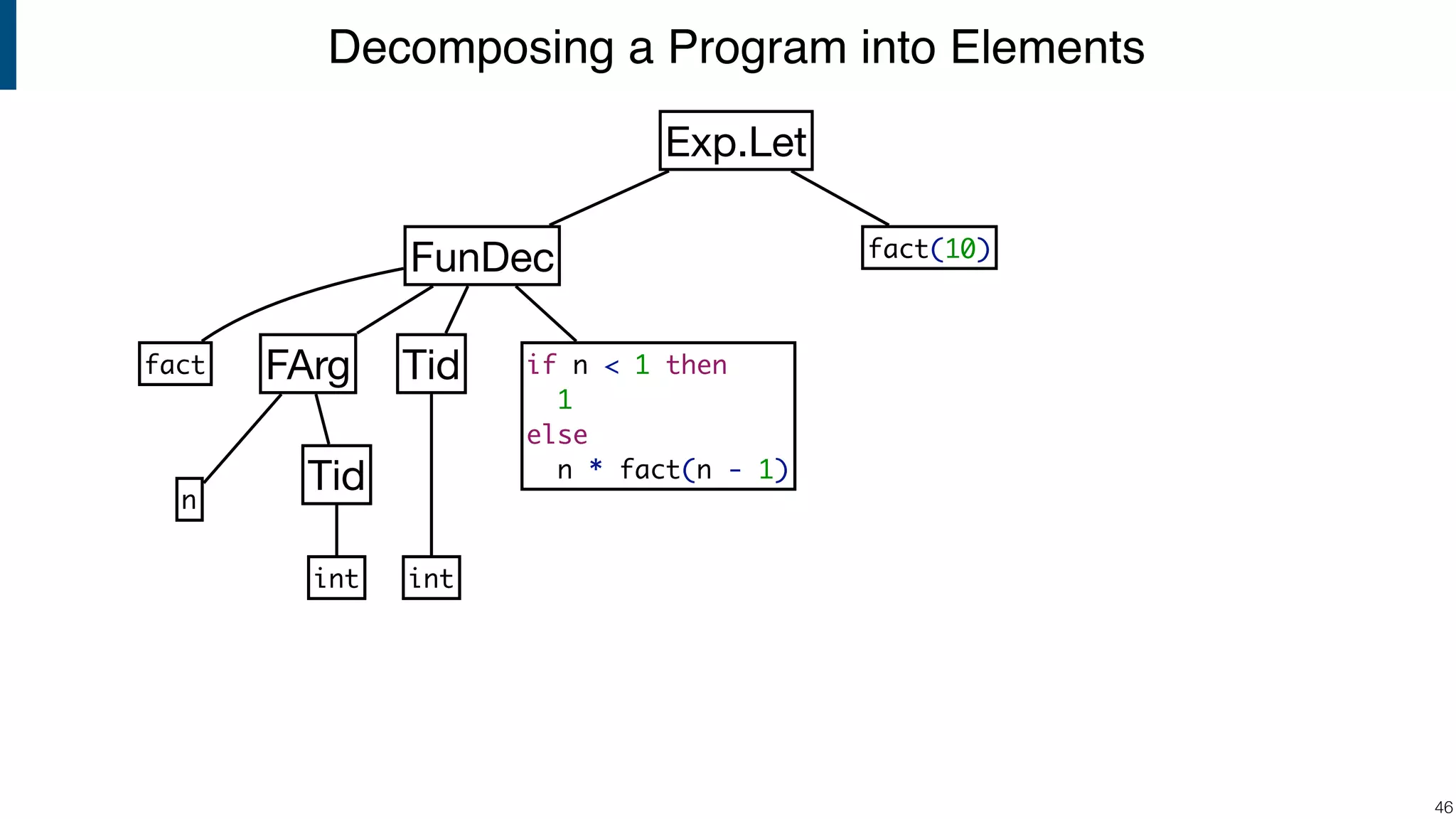

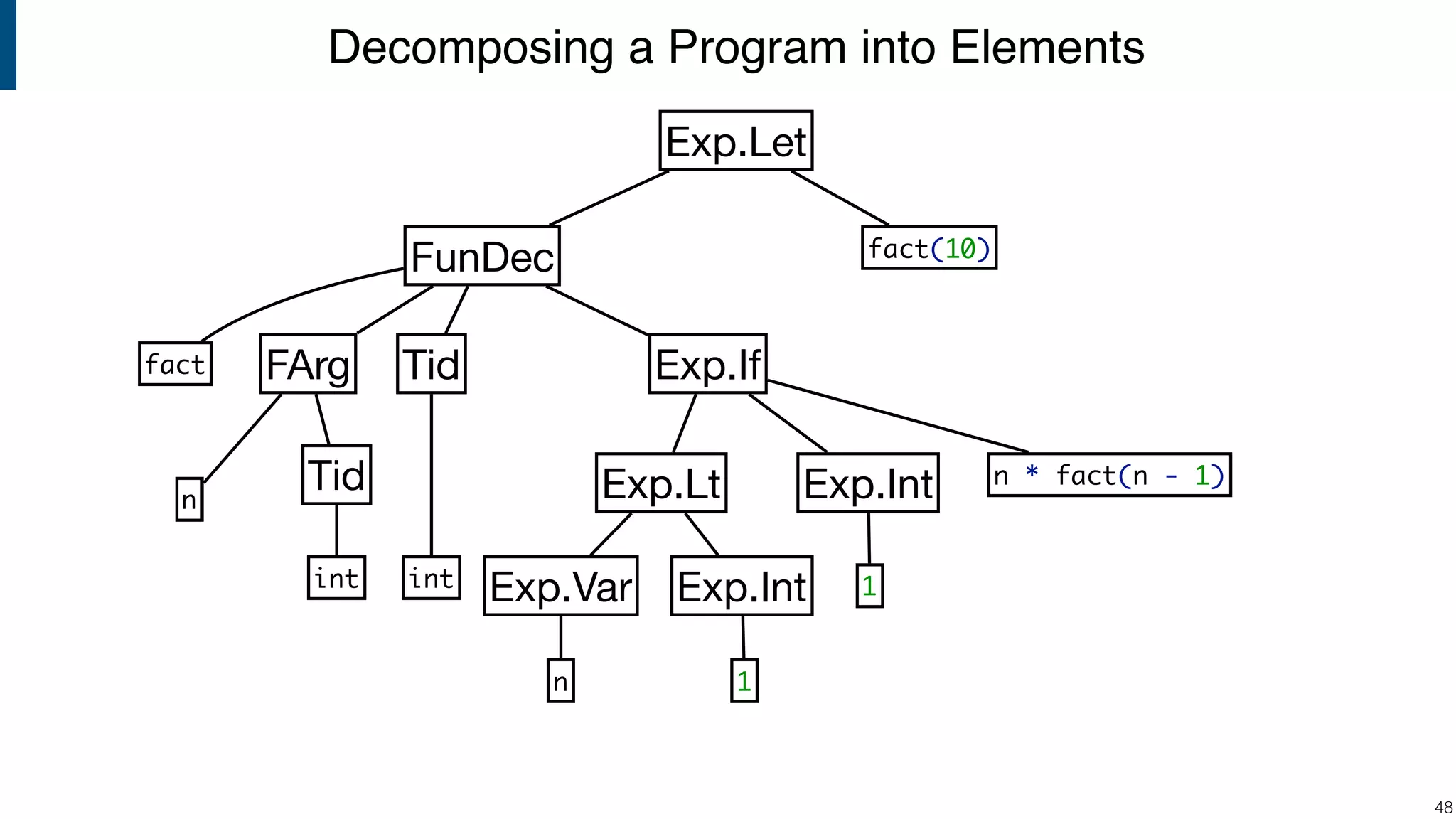
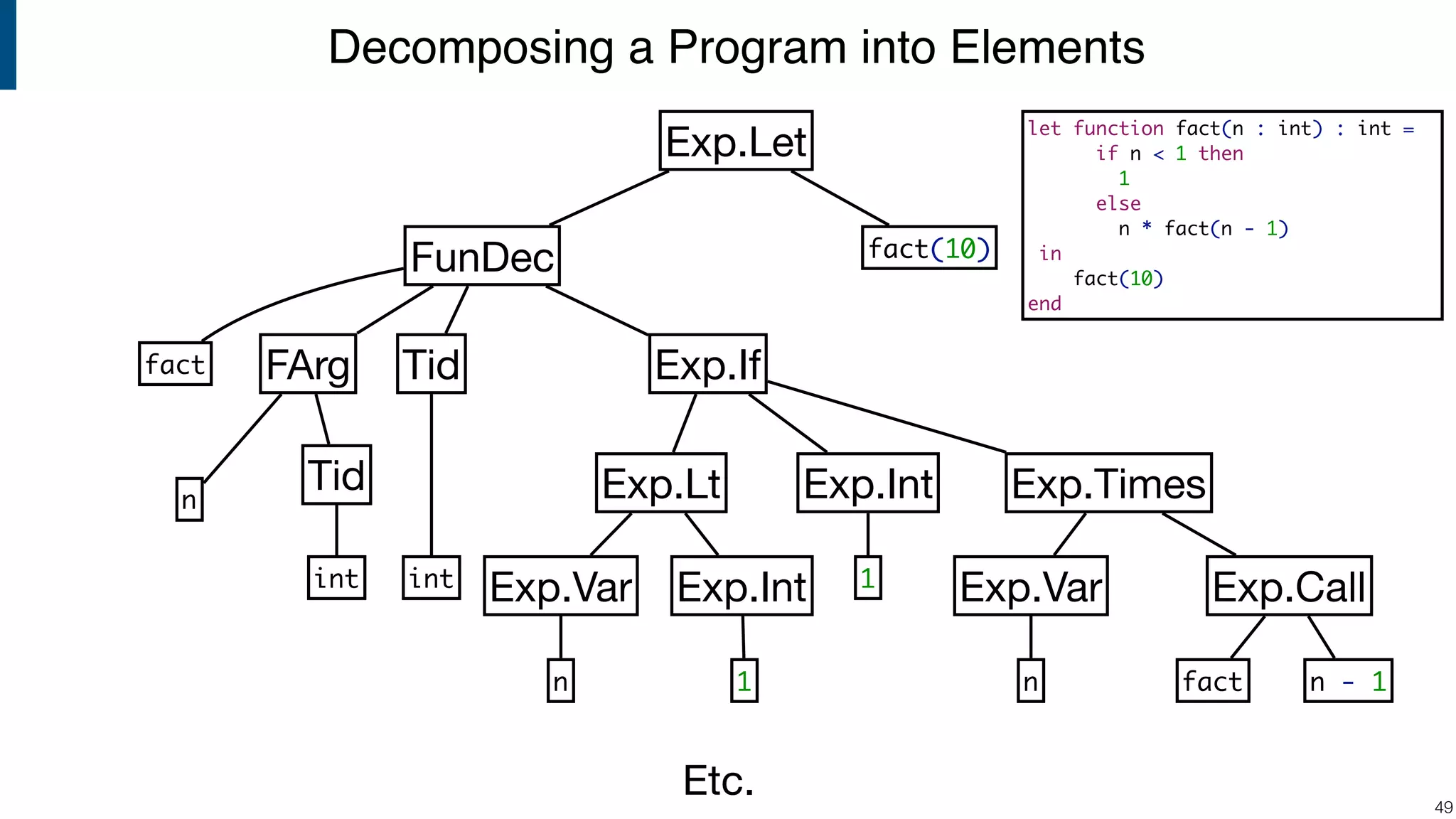
![Tree Structure Represented as (First-Order) Term !50 Mod( Let( [ FunDecs( [ FunDec( "fact" , [FArg("n", Tid("int"))] , Tid("int") , If( Lt(Var("n"), Int("1")) , Int("1") , Times( Var("n") , Call("fact", [Minus(Var("n"), Int("1"))]) ) ) ) ] ) ] , [Call("fact", [Int("10")])] ) ) let function fact(n : int) : int = if n < 1 then 1 else n * fact(n - 1) in fact(10) end](https://image.slidesharecdn.com/cs4200-2018-2-syntax-definition-180907135337/75/Compiler-Construction-Lecture-2-Declarative-Syntax-Definition-50-2048.jpg)
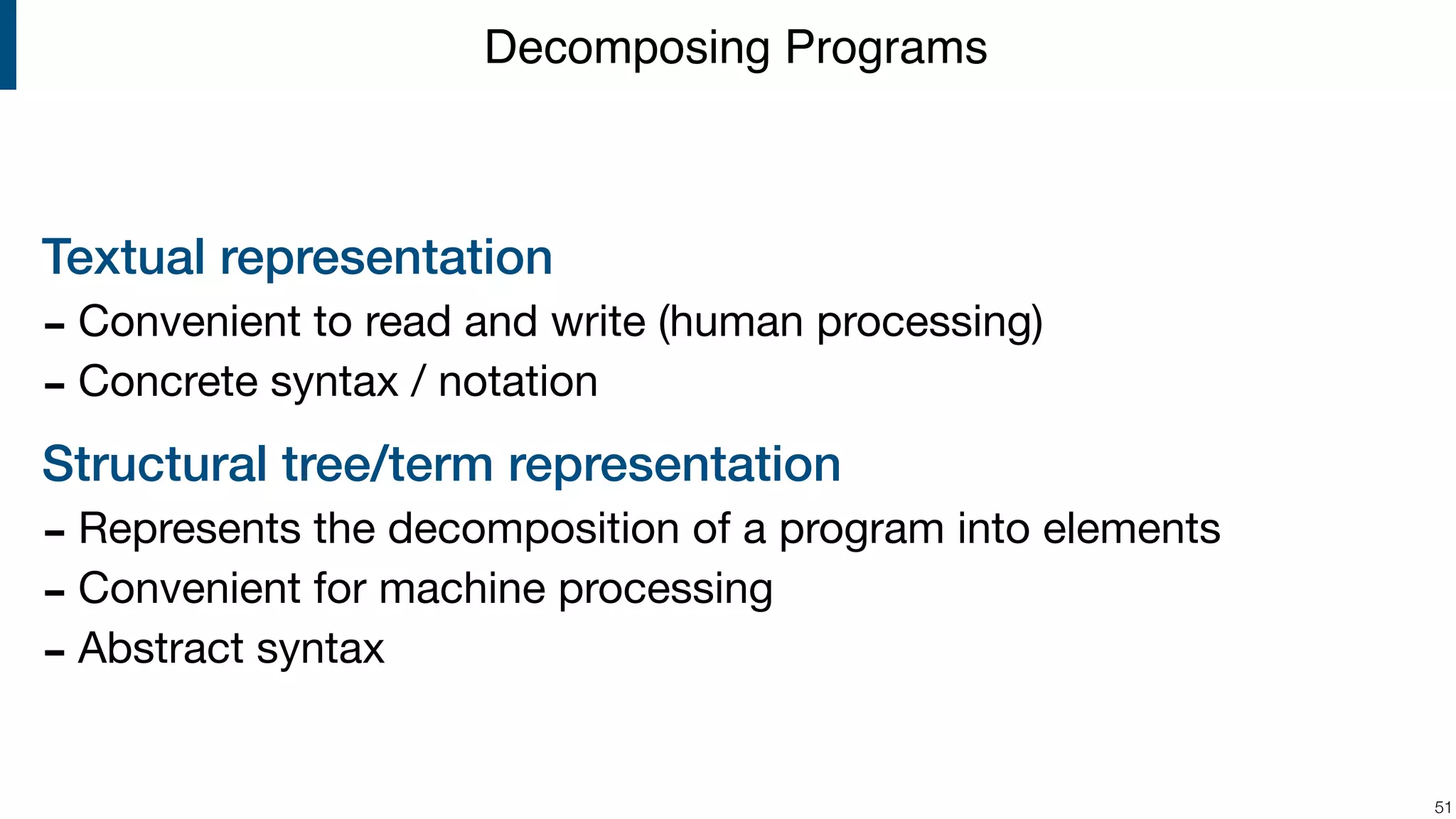

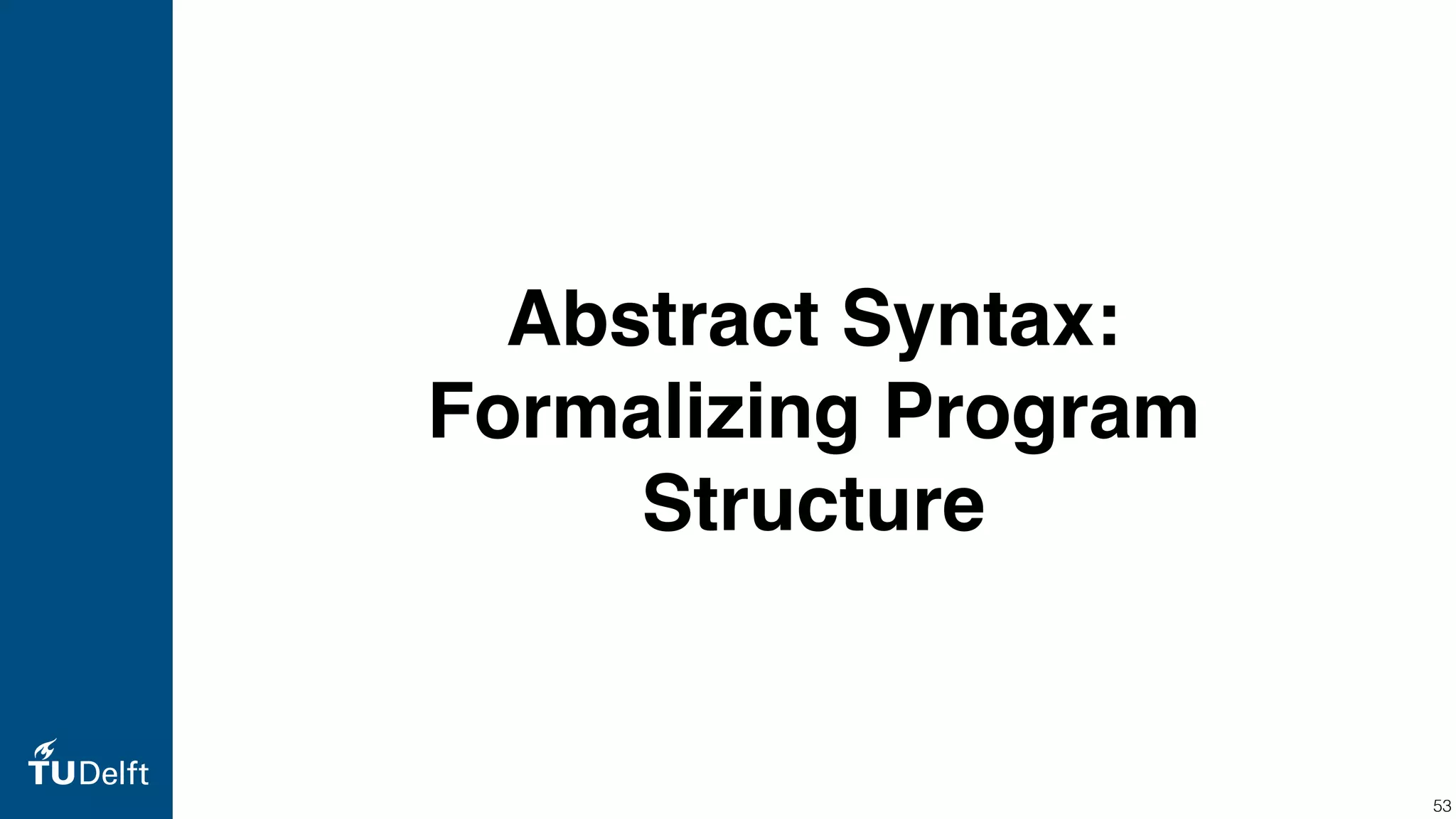
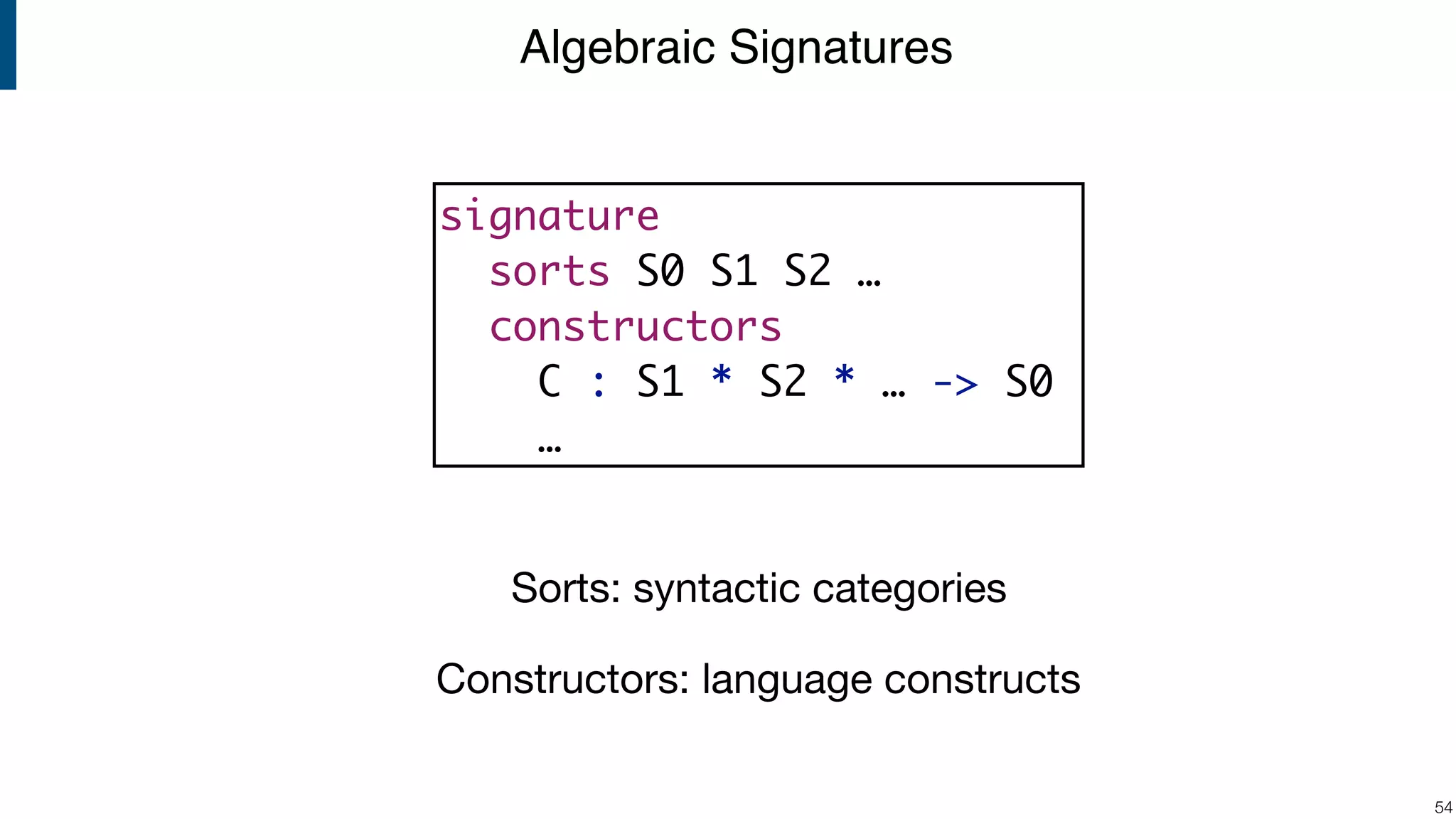
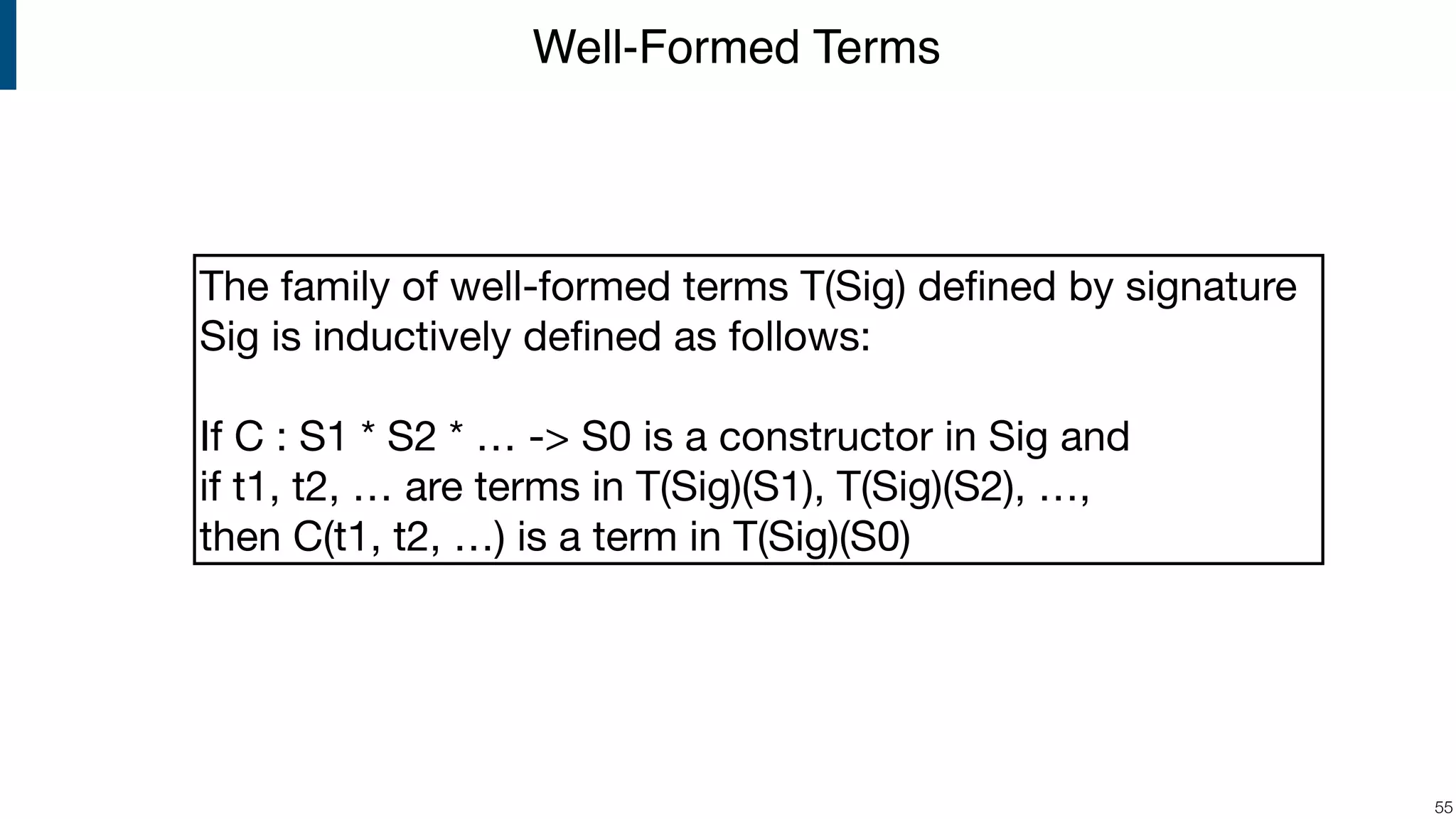
![Well-Formed Terms: Example !56 signature sorts Exp constructors Int : IntConst -> Exp Var : ID -> Exp Times : Exp * Exp -> Exp Minus : Exp * Exp -> Exp Lt : Exp * Exp -> Exp If : Exp * Exp * Exp -> Exp Call : ID * List(Exp) -> Exp if n < 1 then 1 else n * fact(n - 1) If( Lt(Var("n"), Int("1")) , Int("1") , Times( Var("n") , Call("fact", [Minus(Var("n"), Int("1"))]) ) ) decompose well-formed wrt](https://image.slidesharecdn.com/cs4200-2018-2-syntax-definition-180907135337/75/Compiler-Construction-Lecture-2-Declarative-Syntax-Definition-56-2048.jpg)
![Lists of Terms !57 signature sorts Exp Var constructors … Call : ID * List(Exp) -> Exp [Minus(Var("n"), Int(“1”))] [Minus(Var("n"), Int(“1”)), Lt(Var("n"), Int("1"))] []](https://image.slidesharecdn.com/cs4200-2018-2-syntax-definition-180907135337/75/Compiler-Construction-Lecture-2-Declarative-Syntax-Definition-57-2048.jpg)
![Well-Formed Terms with Lists !58 The family of well-formed terms T(Sig) defined by signature Sig is inductively defined as follows: If C : S1 * S2 * … -> S0 is a constructor in Sig and
if t1, t2, … are terms in T(Sig)(S1), T(Sig)(S2), …,
then C(t1, t2, …) is a term in T(Sig)(S0) If t1, t2, … are terms in T(Sig)(S), Then [t1, t2, …] is a term in T(Sig)(List(S))](https://image.slidesharecdn.com/cs4200-2018-2-syntax-definition-180907135337/75/Compiler-Construction-Lecture-2-Declarative-Syntax-Definition-58-2048.jpg)
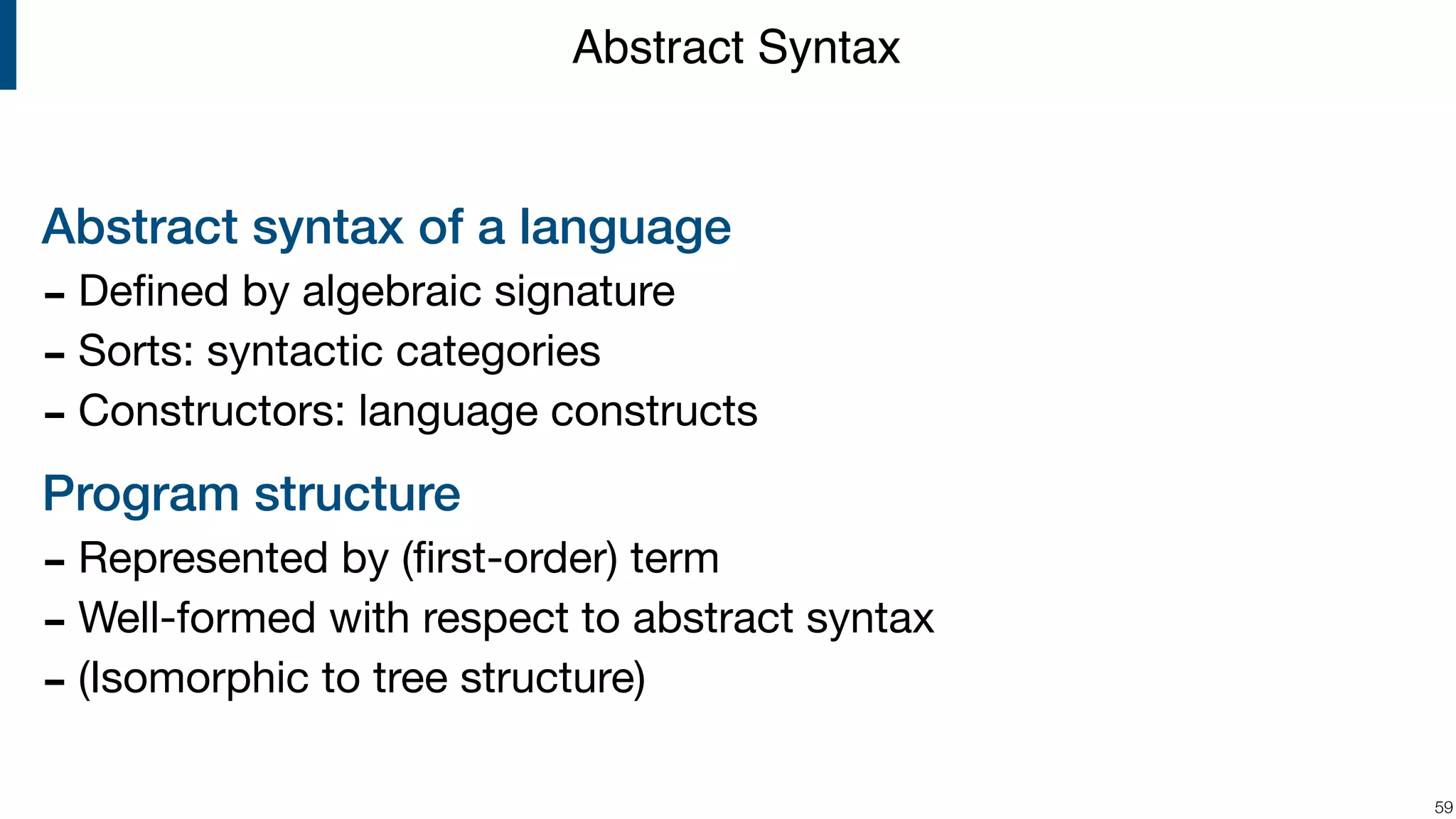
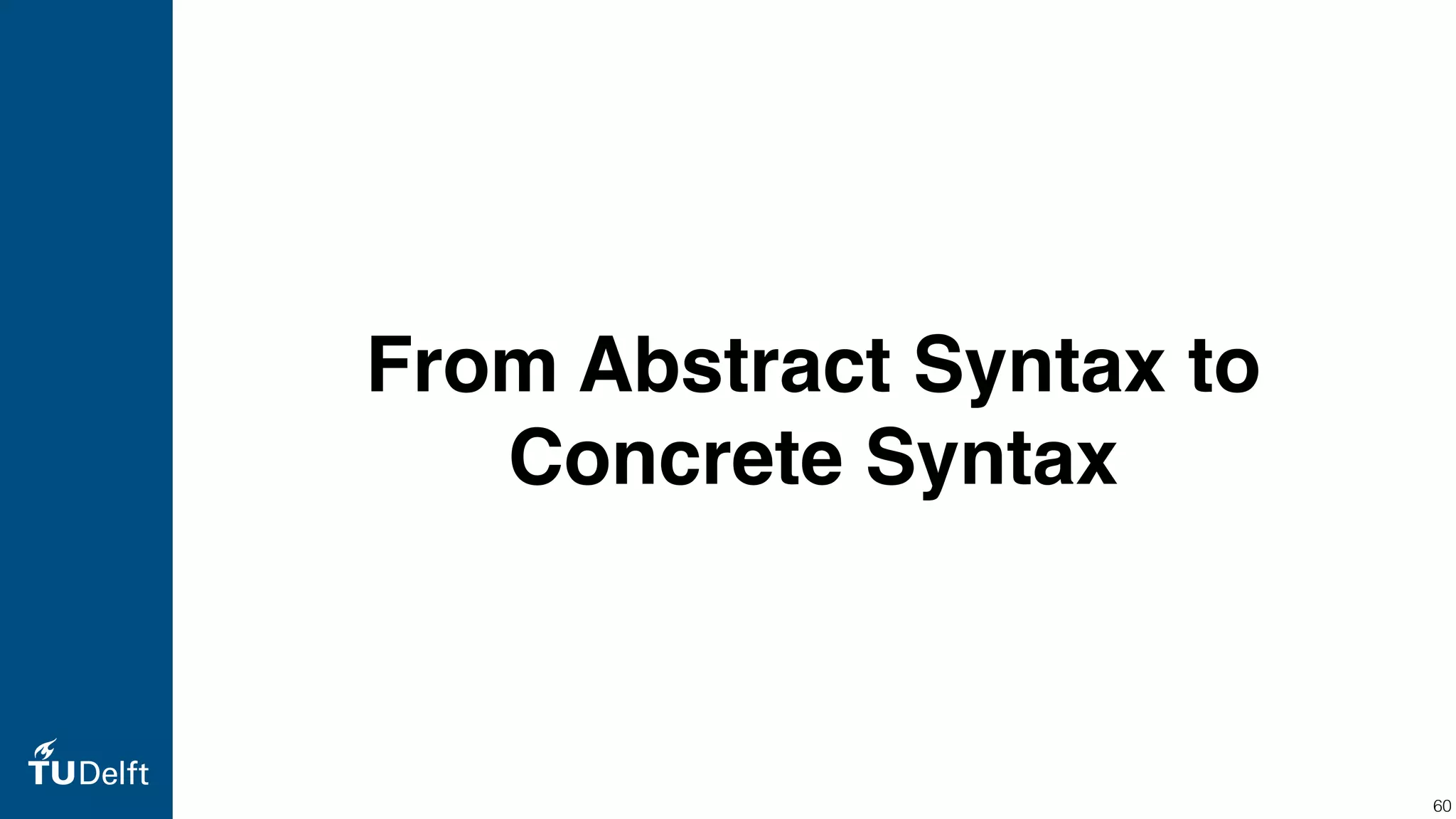
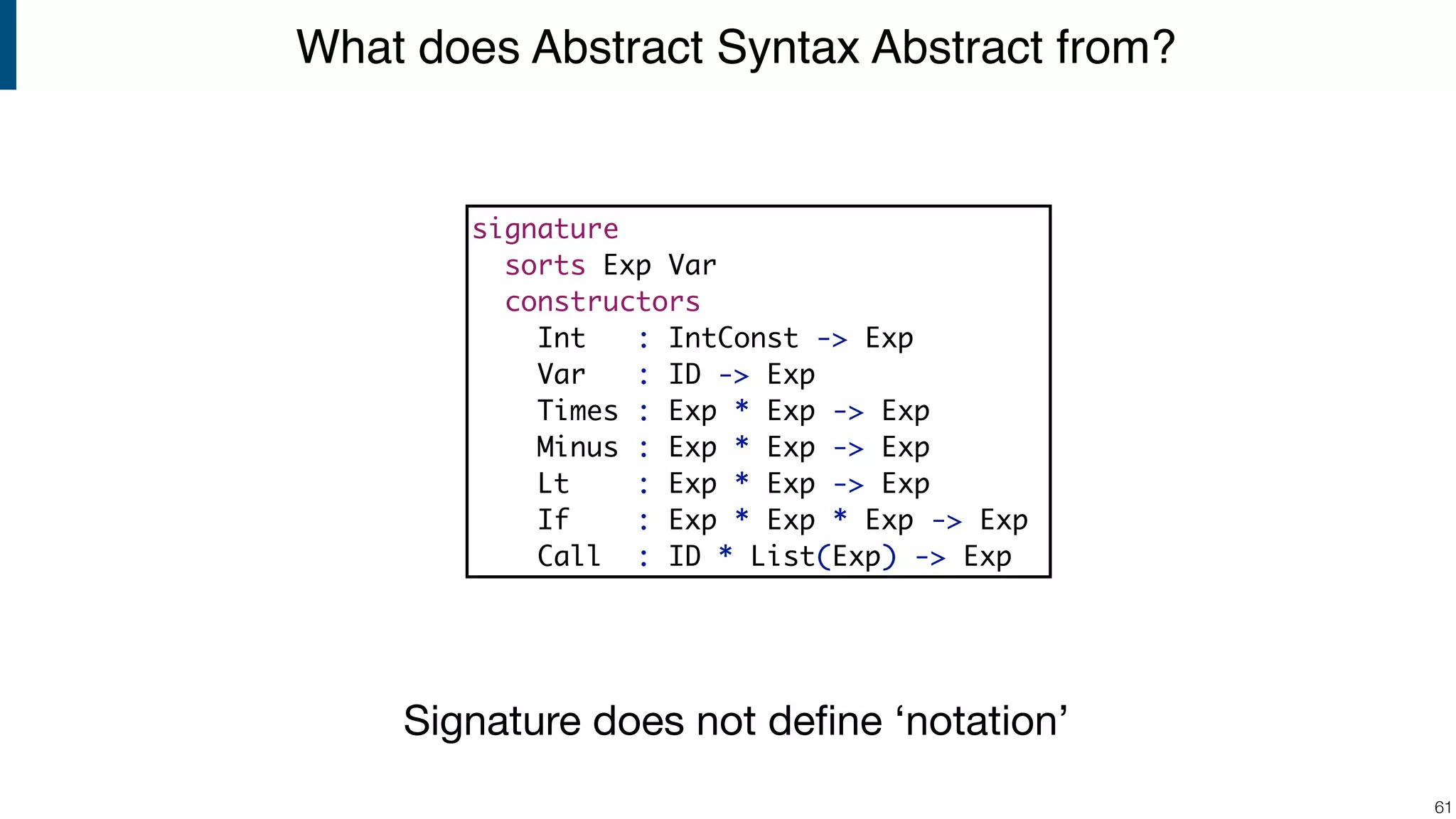
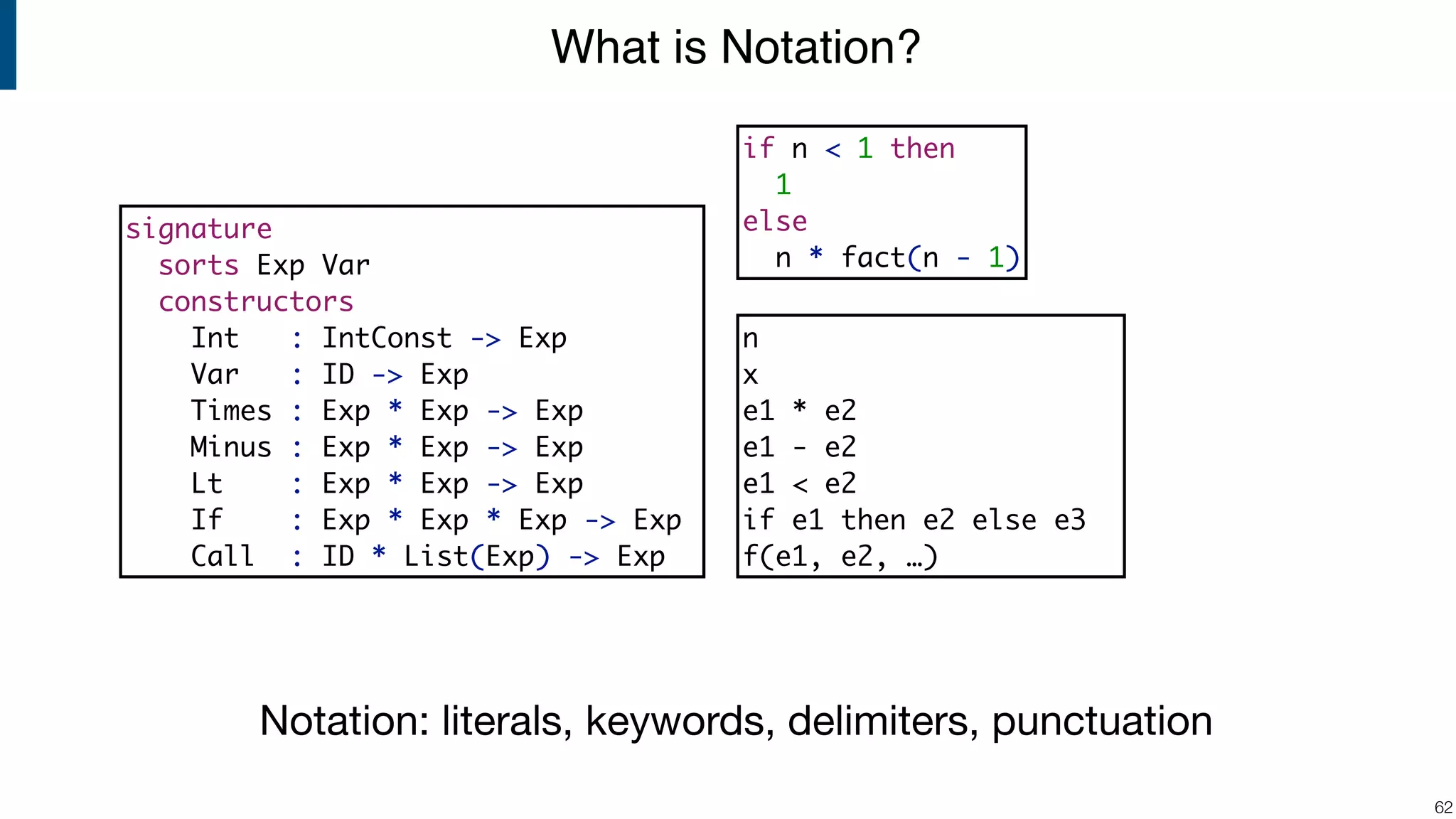

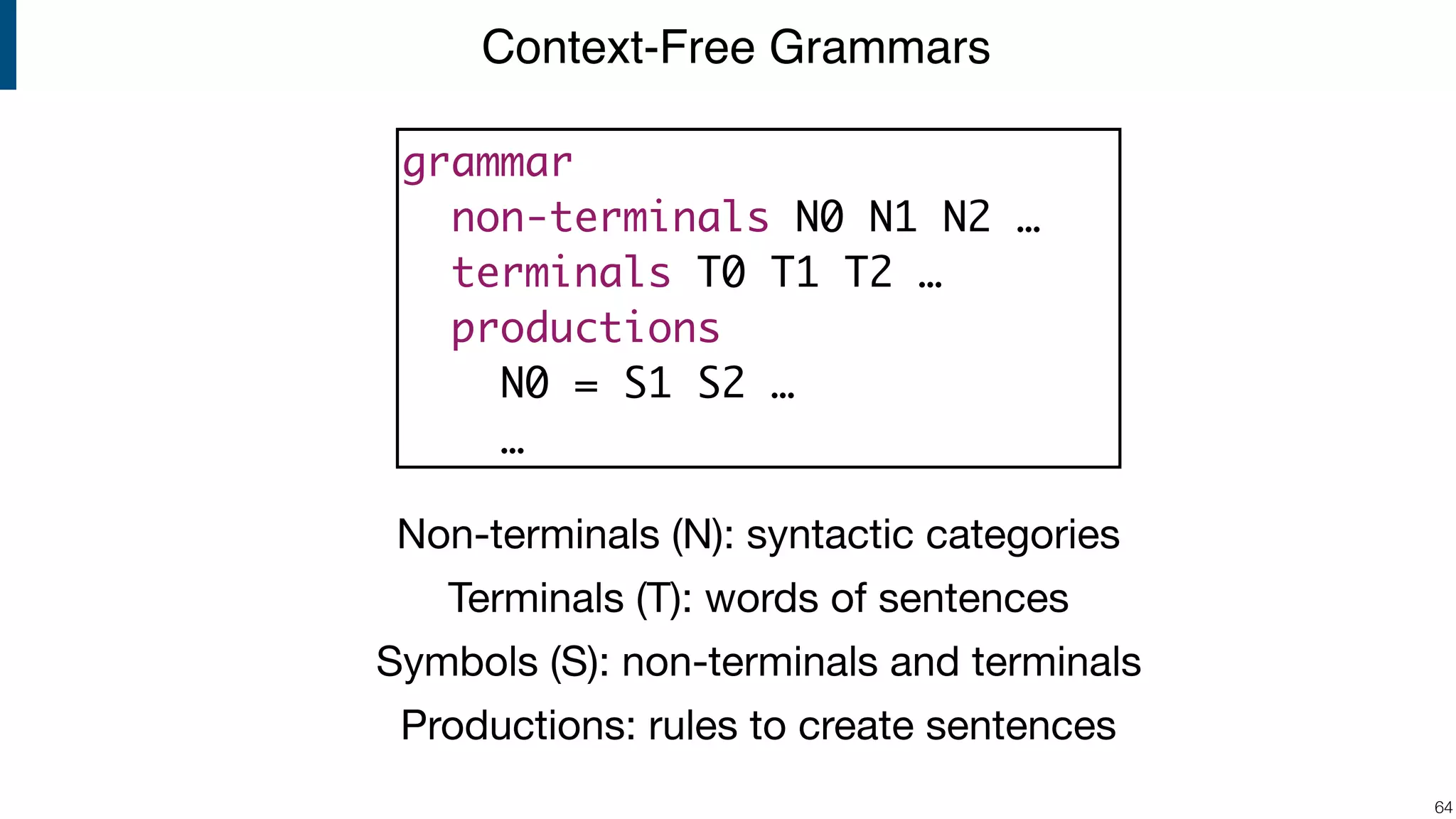
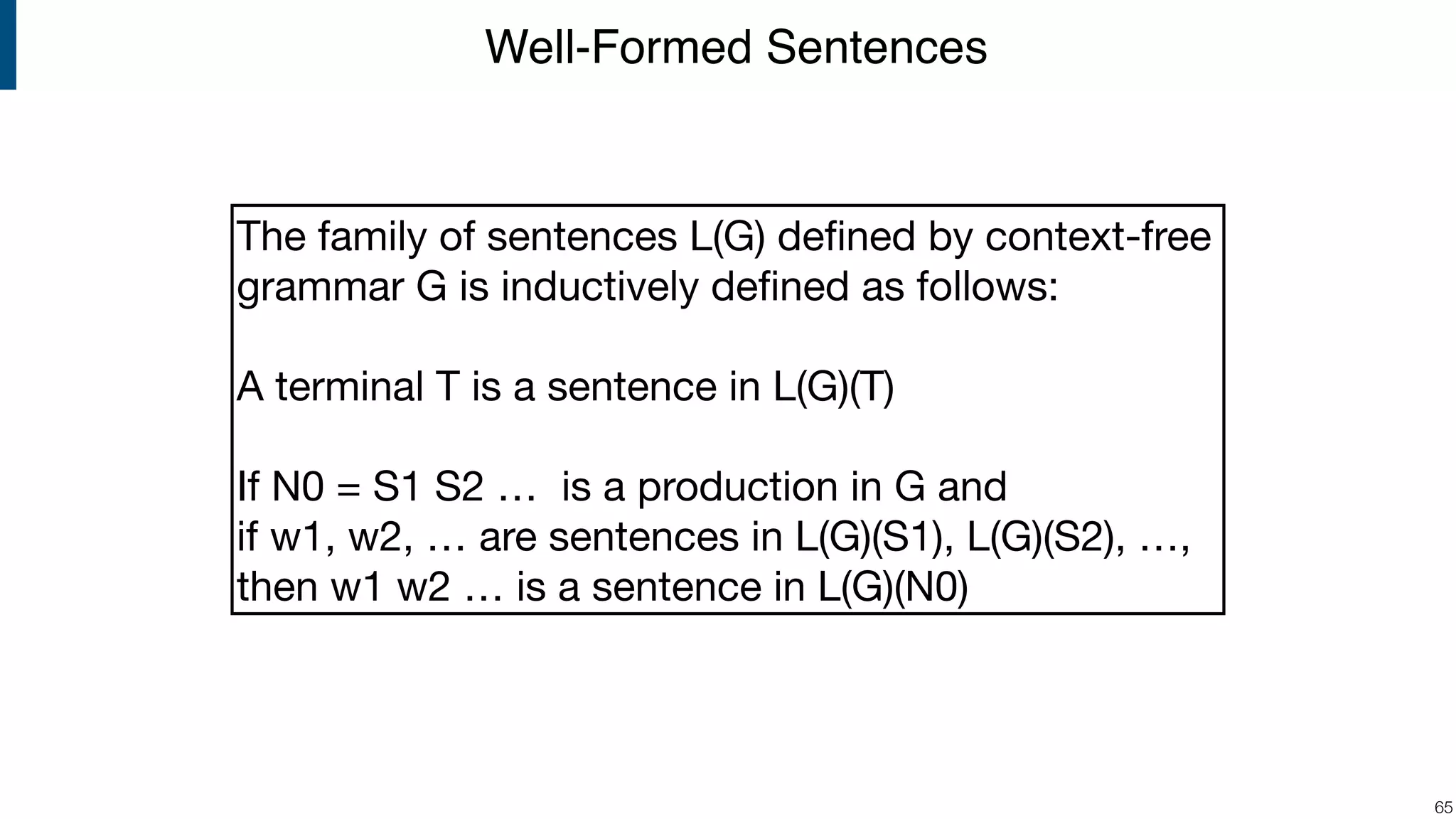

![What is the relation between concrete and abstract syntax? !67 if n < 1 then 1 else n * fact(n - 1) If( Lt(Var("n"), Int("1")) , Int("1") , Times( Var("n") , Call("fact", [Minus(Var("n"), Int("1"))]) ) ) grammar non-terminals Exp Var productions Exp = IntConst Exp = Id Exp = Exp "*" Exp Exp = Exp "-" Exp Exp = Exp "<" Exp Exp = "if" Exp "then" Exp "else" Exp Exp = Id "(" {Exp ","}* ")" ? ? signature sorts Exp Var constructors Int : IntConst -> Exp Var : ID -> Exp Times : Exp * Exp -> Exp Minus : Exp * Exp -> Exp Lt : Exp * Exp -> Exp If : Exp * Exp * Exp -> Exp Call : ID * List(Exp) -> Exp](https://image.slidesharecdn.com/cs4200-2018-2-syntax-definition-180907135337/75/Compiler-Construction-Lecture-2-Declarative-Syntax-Definition-67-2048.jpg)
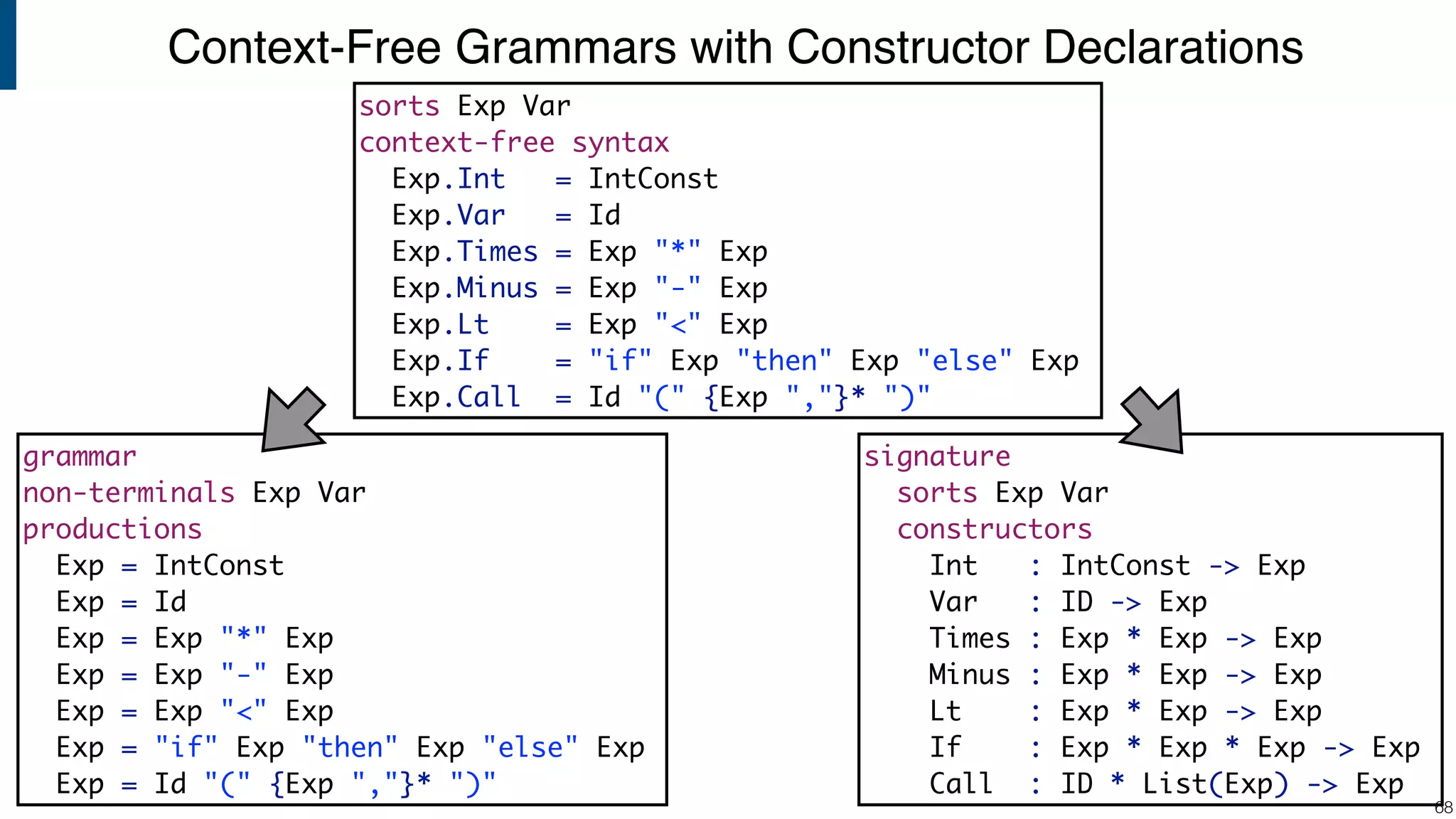

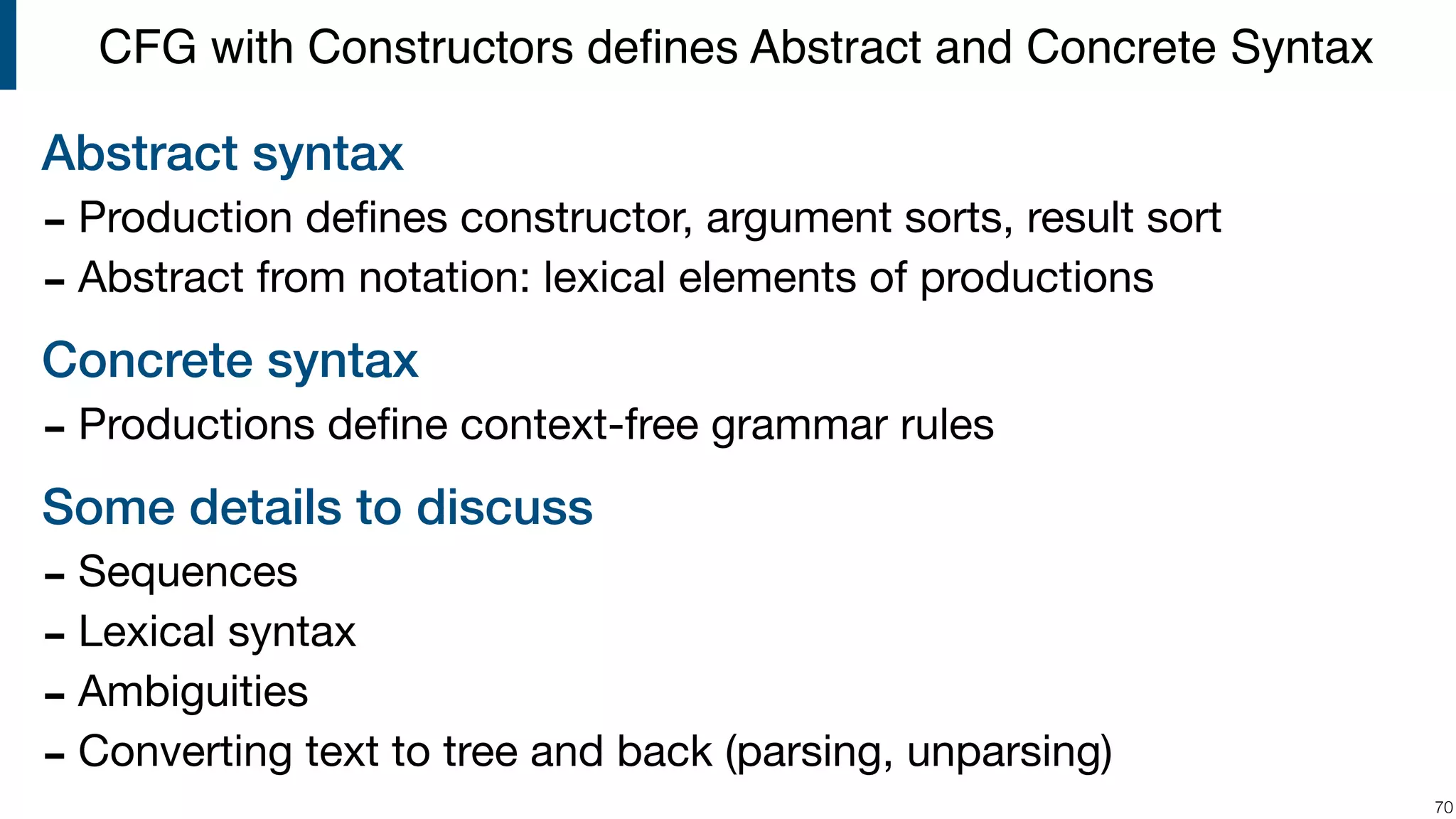
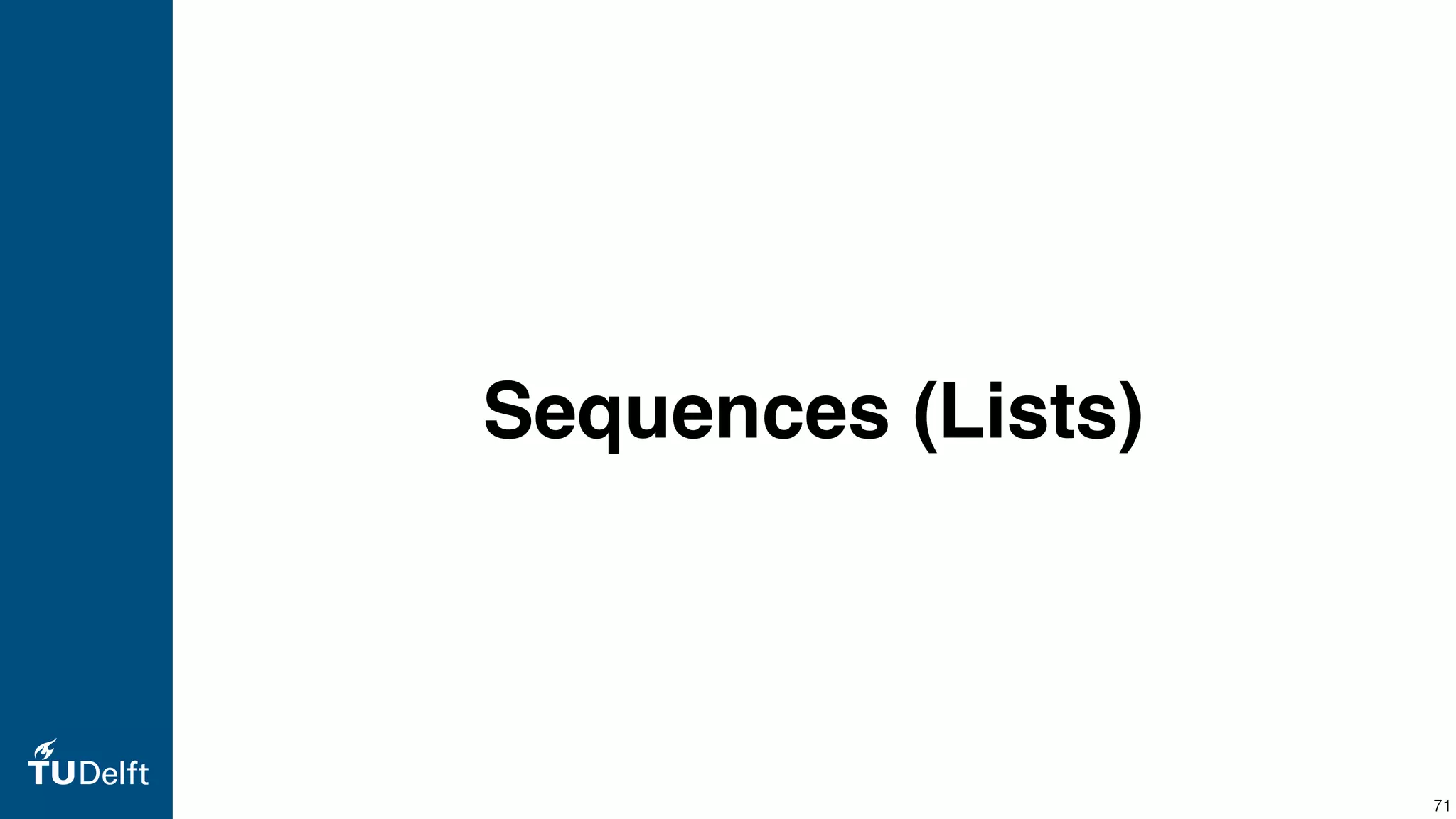
![Encoding Sequences (Lists) !72 sorts Exp Var context-free syntax Exp.Int = IntConst Exp.Var = Id Exp.Times = Exp "*" Exp Exp.Minus = Exp "-" Exp Exp.Lt = Exp "<" Exp Exp.If = "if" Exp "then" Exp "else" Exp Exp.Call = Id "(" ExpList ")" ExpList.Nil = ExpList = ExpListNE ExpListNE.One = Exp ExpListNE.Snoc = ExpListNE “," Exp printlist(merge(list1,list2)) Call("printlist" , [Call("merge", [Var("list1") , Var("list2")])] )](https://image.slidesharecdn.com/cs4200-2018-2-syntax-definition-180907135337/75/Compiler-Construction-Lecture-2-Declarative-Syntax-Definition-72-2048.jpg)
![Sugar for Sequences and Optionals !73 context-free syntax Exp.Call = Id "(" {Exp ","}* ")" printlist(merge(list1,list2)) Call("printlist" , [Call("merge", [Var("list1") , Var("list2")])] ) context-free syntax // automatically generated {Exp “,"}*.Nil = // empty list {Exp “,”}* = {Exp ","}+ {Exp “,"}+.One = Exp {Exp “,"}+.Snoc = {Exp ","}+ "," Exp Exp*.Nil = // empty list Exp* = Exp+ Exp+.One = Exp Exp+.Snoc = Exp+ Exp Exp?.None = // no expression Exp?.Some = Exp // one expression](https://image.slidesharecdn.com/cs4200-2018-2-syntax-definition-180907135337/75/Compiler-Construction-Lecture-2-Declarative-Syntax-Definition-73-2048.jpg)
![Normalizing Lists !74 rules Snoc(Nil(), x) -> Cons(x, Nil()) Snoc(Cons(x, xs), y) -> Cons(x, Snoc(xs, y)) One(x) -> Cons(x, Nil()) Nil() -> [] Cons(x, xs) -> [x | xs] context-free syntax // automatically generated {Exp “,"}*.Nil = // empty list {Exp “,”}* = {Exp ","}+ {Exp “,"}+.One = Exp {Exp “,"}+.Snoc = {Exp ","}+ "," Exp Exp*.Nil = // empty list Exp* = Exp+ Exp+.One = Exp Exp+.Snoc = Exp+ Exp Exp?.None = // no expression Exp?.Some = Exp // one expression](https://image.slidesharecdn.com/cs4200-2018-2-syntax-definition-180907135337/75/Compiler-Construction-Lecture-2-Declarative-Syntax-Definition-74-2048.jpg)
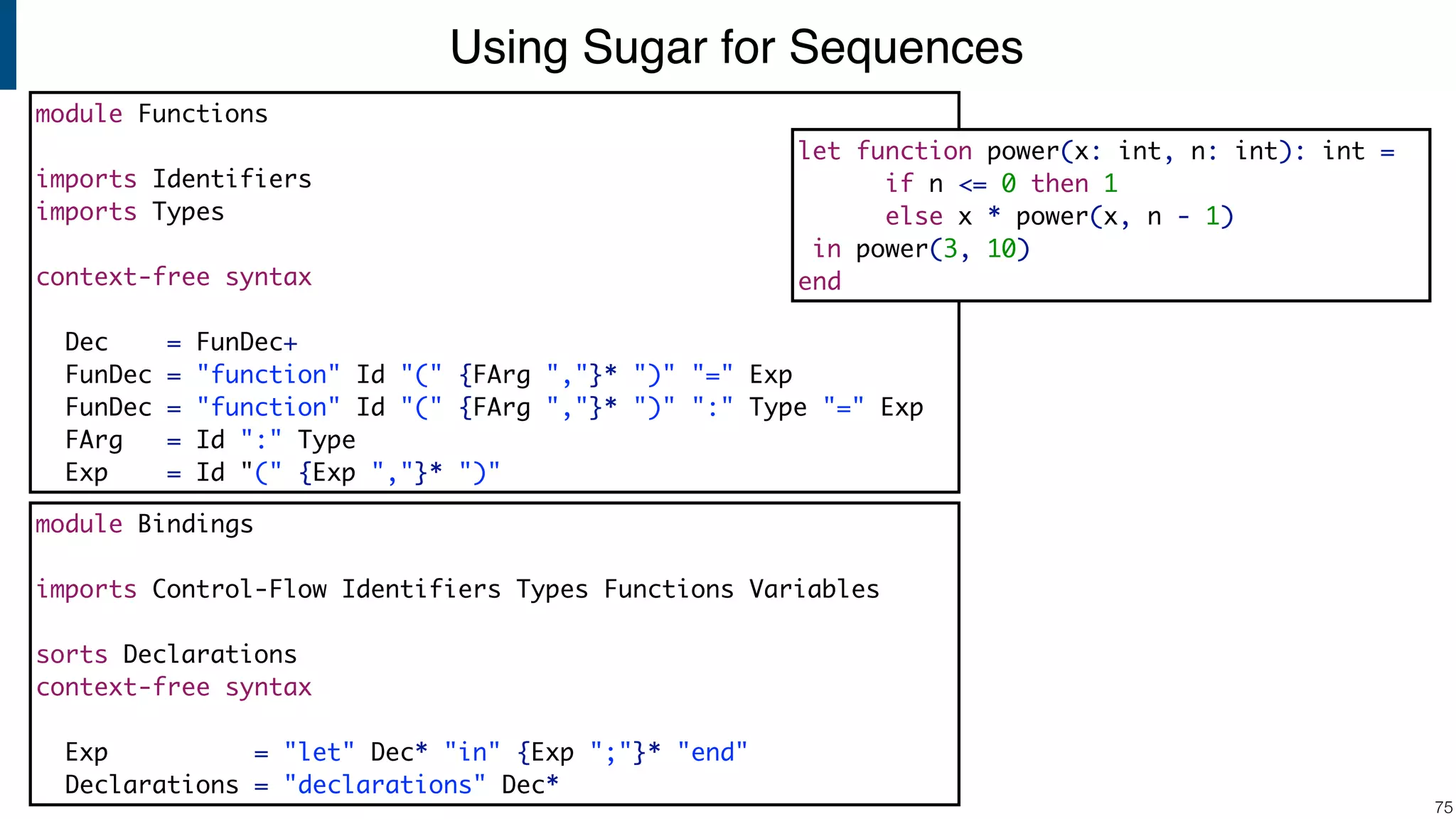
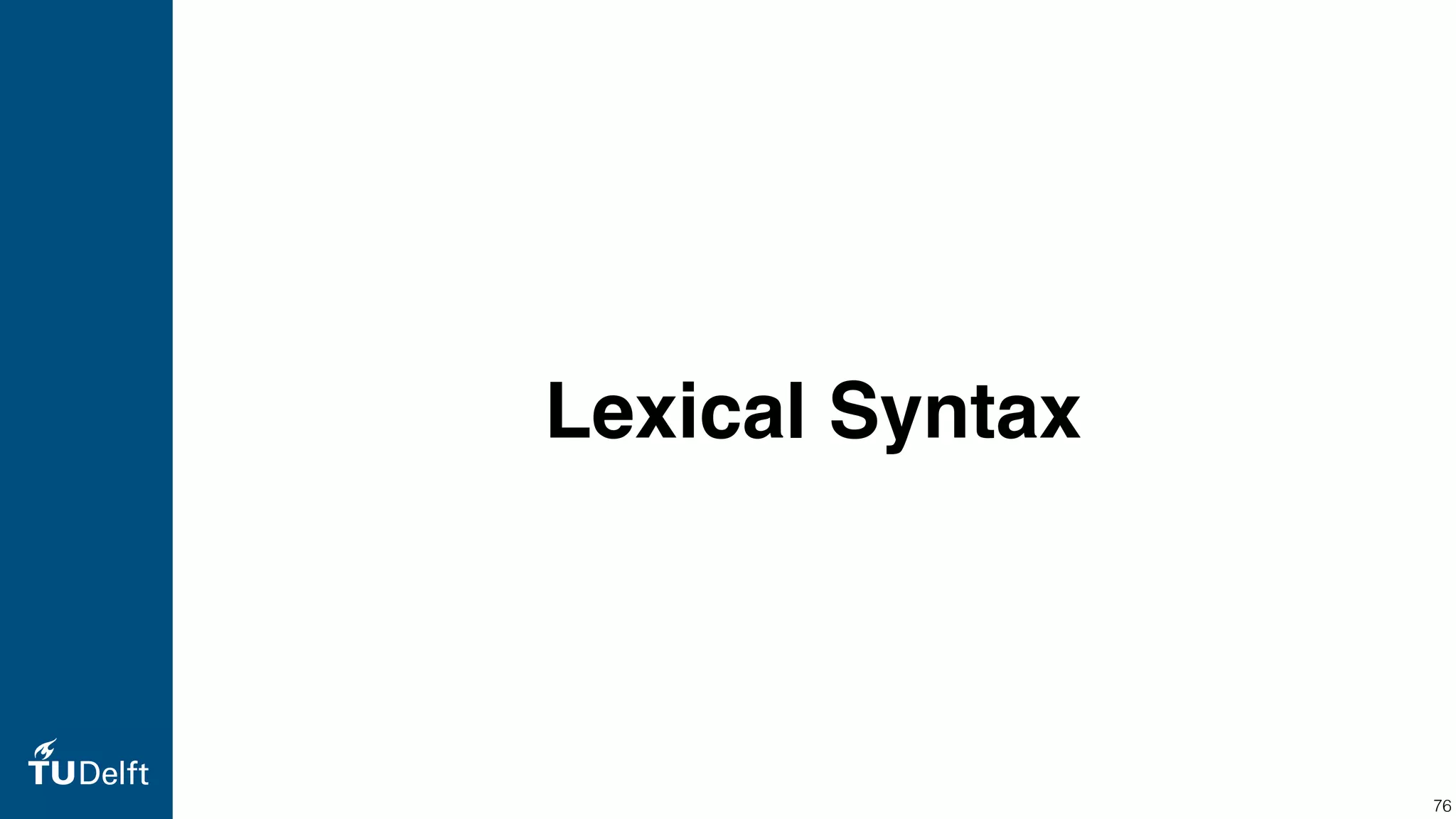
![Context-Free Syntax vs Lexical Syntax !77 let function power(x: int, n: int): int = if n <= 0 then 1 else x * power(x, n - 1) in power(3, 10) end Mod( Let( [ FunDecs( [ FunDec( "power" , [FArg("x", Tid("int")), FArg("n", Tid("int"))] , Tid("int") , If( Leq(Var("n"), Int("0")) , Int("1") , Times( Var("x") , Call( "power" , [Var("x"), Minus(Var("n"), Int("1"))] ) ) ) ) ] ) ] , [Call("power", [Int("3"), Int("10")])] ) ) phrase structure lexeme / token separated by layout structure not relevant not separated by layout](https://image.slidesharecdn.com/cs4200-2018-2-syntax-definition-180907135337/75/Compiler-Construction-Lecture-2-Declarative-Syntax-Definition-77-2048.jpg)
![Character Classes !78 lexical syntax // character codes Character = [65] Range = [65-90] Union = [65-90] / [97-122] Difference = [0-127] / [1013] Union = [0-911-1214-255] Character class represents choice from a set of characters](https://image.slidesharecdn.com/cs4200-2018-2-syntax-definition-180907135337/75/Compiler-Construction-Lecture-2-Declarative-Syntax-Definition-78-2048.jpg)
![Sugar for Character Classes !79 lexical syntax // sugar CharSugar = [a] = [97] CharClass = [abcdefghijklmnopqrstuvwxyz] = [97-122] SugarRange = [a-z] = [97-122] Union = [a-z] / [A-Z] / [0-9] = [48-5765-9097-122] RangeCombi = [a-z0-9_] = [48-579597-122] Complement = ~[nr] = [0-255] / [1013] = [0-911-1214-255]](https://image.slidesharecdn.com/cs4200-2018-2-syntax-definition-180907135337/75/Compiler-Construction-Lecture-2-Declarative-Syntax-Definition-79-2048.jpg)
![Literals are Sequences of Characters !80 lexical syntax // literals Literal = "then" // case sensitive sequence of characters CaseInsensitive = 'then' // case insensitive sequence of characters syntax "then" = [116] [104] [101] [110] 'then' = [84116] [72104] [69101] [78110] syntax "then" = [t] [h] [e] [n] 'then' = [Tt] [Hh] [Ee] [Nn]](https://image.slidesharecdn.com/cs4200-2018-2-syntax-definition-180907135337/75/Compiler-Construction-Lecture-2-Declarative-Syntax-Definition-80-2048.jpg)
![Identifiers !81 lexical syntax Id = [a-zA-Z] [a-zA-Z0-9_]* Id = a Id = B Id = cD Id = xyz10 Id = internal_ Id = CamelCase Id = lower_case Id = ...](https://image.slidesharecdn.com/cs4200-2018-2-syntax-definition-180907135337/75/Compiler-Construction-Lecture-2-Declarative-Syntax-Definition-81-2048.jpg)
![Lexical Ambiguity: Longest Match !82 lexical syntax Id = [a-zA-Z] [a-zA-Z0-9_]* context-free syntax Exp.Var = Id Exp.Call = Exp Exp {left} // curried function call ab Mod( amb( [Var("ab"), Call(Var("a"), Var("b"))] ) )](https://image.slidesharecdn.com/cs4200-2018-2-syntax-definition-180907135337/75/Compiler-Construction-Lecture-2-Declarative-Syntax-Definition-82-2048.jpg)
![abc Lexical Ambiguity: Longest Match !83 Mod( amb( [ amb( [ Var("abc") , Call( amb( [Var("ab"), Call(Var("a"), Var("b"))] ) , Var("c") ) ] ) , Call(Var("a"), Var("bc")) ] ) ) lexical syntax Id = [a-zA-Z] [a-zA-Z0-9_]* context-free syntax Exp.Var = Id Exp.Call = Exp Exp {left} // curried function call](https://image.slidesharecdn.com/cs4200-2018-2-syntax-definition-180907135337/75/Compiler-Construction-Lecture-2-Declarative-Syntax-Definition-83-2048.jpg)
![abc def ghi Lexical Restriction => Longest Match !84 lexical syntax Id = [a-zA-Z] [a-zA-Z0-9_]* lexical restrictions Id -/- [a-zA-Z0-9_] // longest match for identifiers context-free syntax Exp.Var = Id Exp.Call = Exp Exp {left} // curried function call Call(Call(Var("abc"), Var("def")), Var("ghi")) Lexical restriction: phrase cannot be followed by character in character class](https://image.slidesharecdn.com/cs4200-2018-2-syntax-definition-180907135337/75/Compiler-Construction-Lecture-2-Declarative-Syntax-Definition-84-2048.jpg)
![if def then ghi Lexical Ambiguity: Keywords overlap with Identifiers !85 lexical syntax Id = [a-zA-Z] [a-zA-Z0-9_]* lexical restrictions Id -/- [a-zA-Z0-9_] // longest match for identifiers context-free syntax Exp.Var = Id Exp.Call = Exp Exp {left} Exp.IfThen = "if" Exp "then" Exp amb( [ Mod( Call( Call(Call(Var("if"), Var("def")), Var("then")) , Var("ghi") ) ) , Mod(IfThen(Var("def"), Var("ghi"))) ] )](https://image.slidesharecdn.com/cs4200-2018-2-syntax-definition-180907135337/75/Compiler-Construction-Lecture-2-Declarative-Syntax-Definition-85-2048.jpg)
![ifdef then ghi Lexical Ambiguity: Keywords overlap with Identifiers !86 amb( [ Mod( Call(Call(Var("ifdef"), Var("then")), Var("ghi")) ) , Mod(IfThen(Var("def"), Var("ghi"))) ] ) lexical syntax Id = [a-zA-Z] [a-zA-Z0-9_]* lexical restrictions Id -/- [a-zA-Z0-9_] // longest match for identifiers context-free syntax Exp.Var = Id Exp.Call = Exp Exp {left} Exp.IfThen = "if" Exp "then" Exp](https://image.slidesharecdn.com/cs4200-2018-2-syntax-definition-180907135337/75/Compiler-Construction-Lecture-2-Declarative-Syntax-Definition-86-2048.jpg)
![Reject Productions => Reserved Words !87 lexical syntax Id = [a-zA-Z] [a-zA-Z0-9_]* Id = "if" {reject} Id = "then" {reject} lexical restrictions Id -/- [a-zA-Z0-9_] // longest match for identifiers "if" "then" -/- [a-zA-Z0-9_] context-free syntax Exp.Var = Id Exp.Call = Exp Exp {left} Exp.IfThen = "if" Exp "then" Exp if def then ghi IfThen(Var("def"), Var("ghi"))](https://image.slidesharecdn.com/cs4200-2018-2-syntax-definition-180907135337/75/Compiler-Construction-Lecture-2-Declarative-Syntax-Definition-87-2048.jpg)
![ifdef then ghi Reject Productions => Reserved Words !88 parse error lexical syntax Id = [a-zA-Z] [a-zA-Z0-9_]* Id = "if" {reject} Id = "then" {reject} lexical restrictions Id -/- [a-zA-Z0-9_] // longest match for identifiers "if" "then" -/- [a-zA-Z0-9_] context-free syntax Exp.Var = Id Exp.Call = Exp Exp {left} Exp.IfThen = "if" Exp "then" Exp](https://image.slidesharecdn.com/cs4200-2018-2-syntax-definition-180907135337/75/Compiler-Construction-Lecture-2-Declarative-Syntax-Definition-88-2048.jpg)

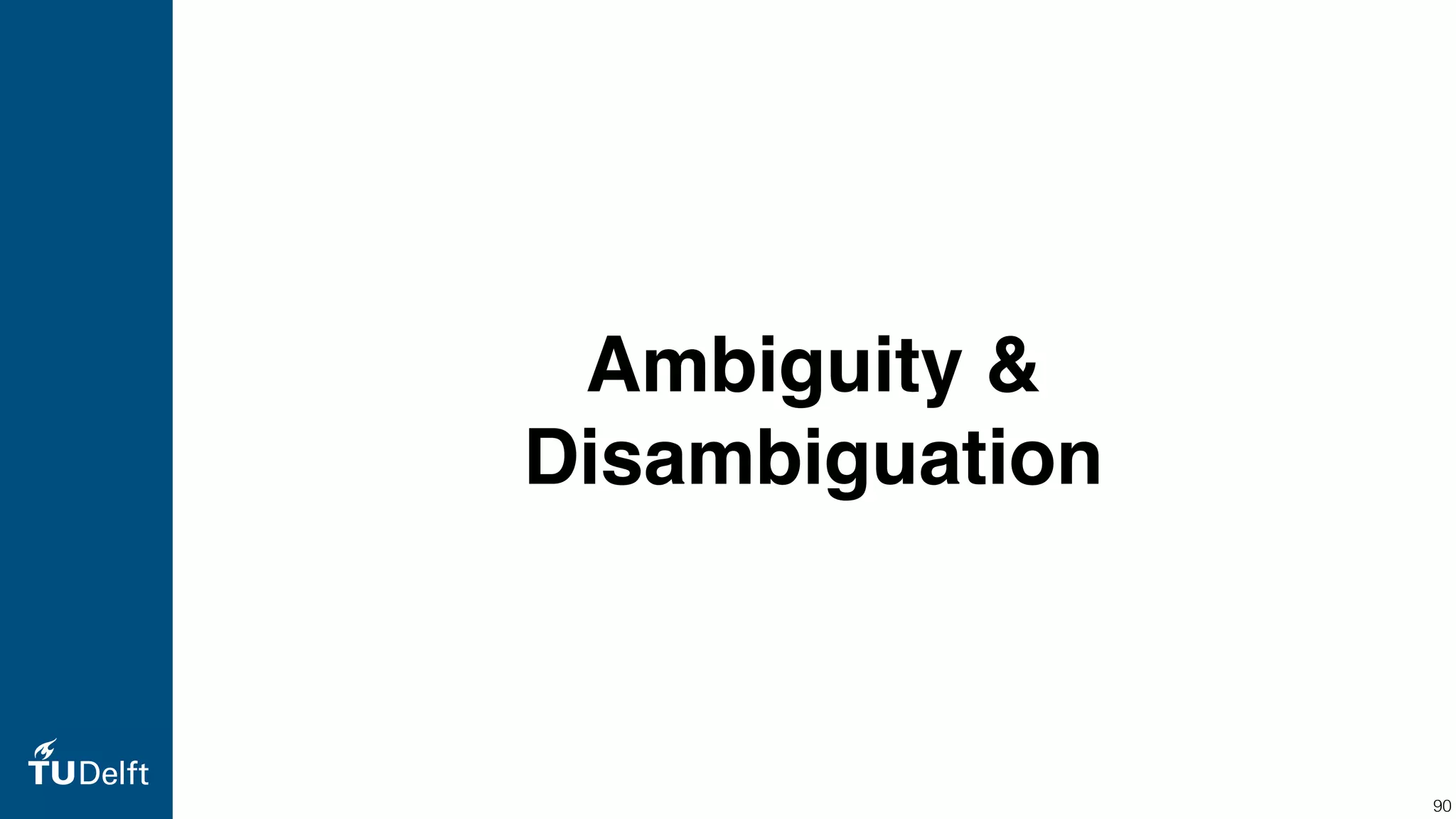

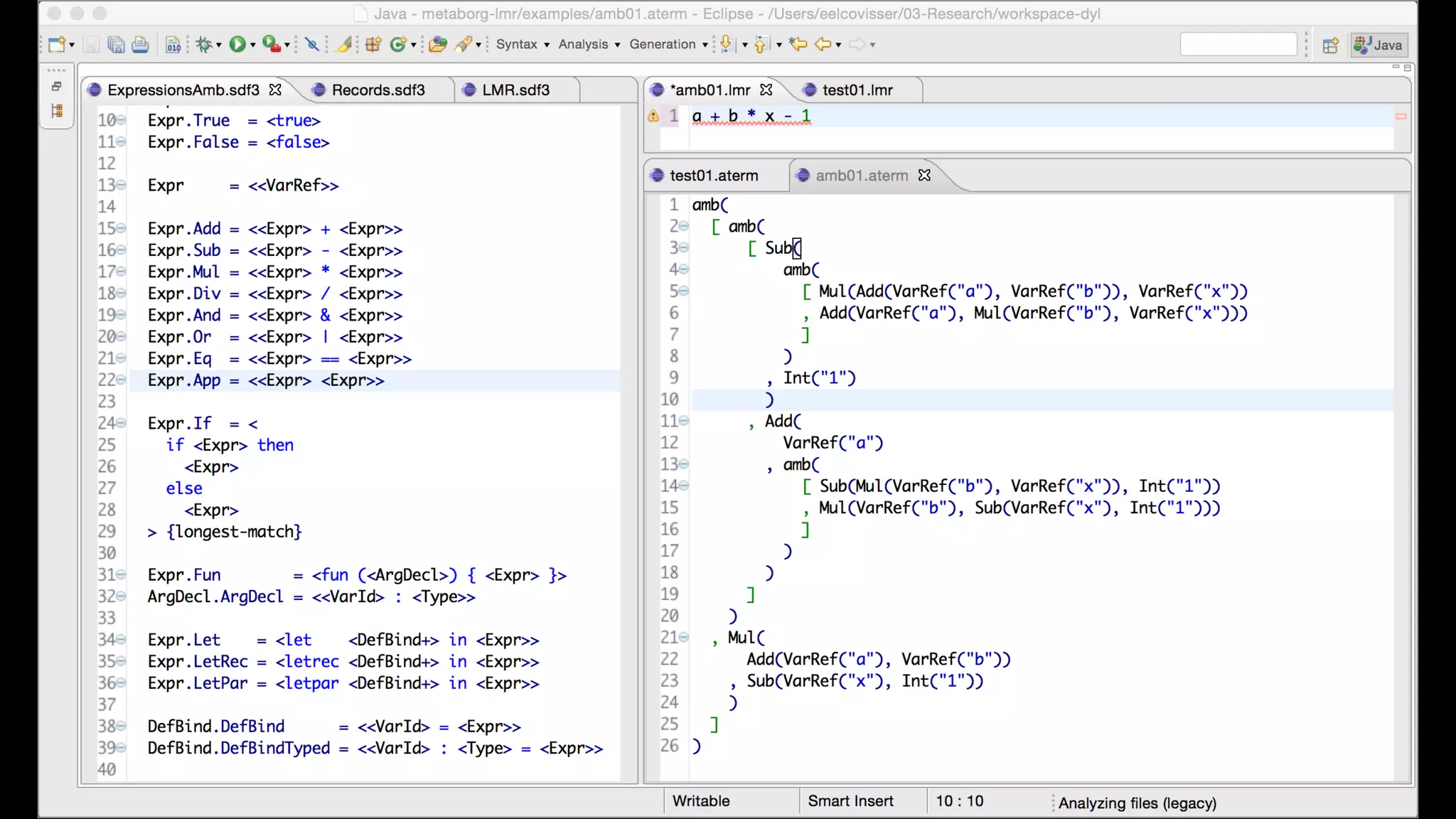
![Disambiguation Filters !93 parse filter Disambiguation Filters [Klint & Visser; 1994], [Van den Brand, Scheerder, Vinju, Visser; CC 2002]](https://image.slidesharecdn.com/cs4200-2018-2-syntax-definition-180907135337/75/Compiler-Construction-Lecture-2-Declarative-Syntax-Definition-93-2048.jpg)
![Associativity and Priority !94 context-free syntax Expr.Int = INT Expr.Add = "Expr" + "Expr" {left} Expr.Mul = "Expr" * "Expr" {left} context-free priorities Expr.Mul > Expr.Add Recent improvement: safe disambiguation of operator precedence [SLE13, Onward15, Programming18] Add VarRef VarRef “y”“x” Mul Int “3” Add VarRef VarRef “y” “x” Mul Int “3” 3 * x + y](https://image.slidesharecdn.com/cs4200-2018-2-syntax-definition-180907135337/75/Compiler-Construction-Lecture-2-Declarative-Syntax-Definition-94-2048.jpg)
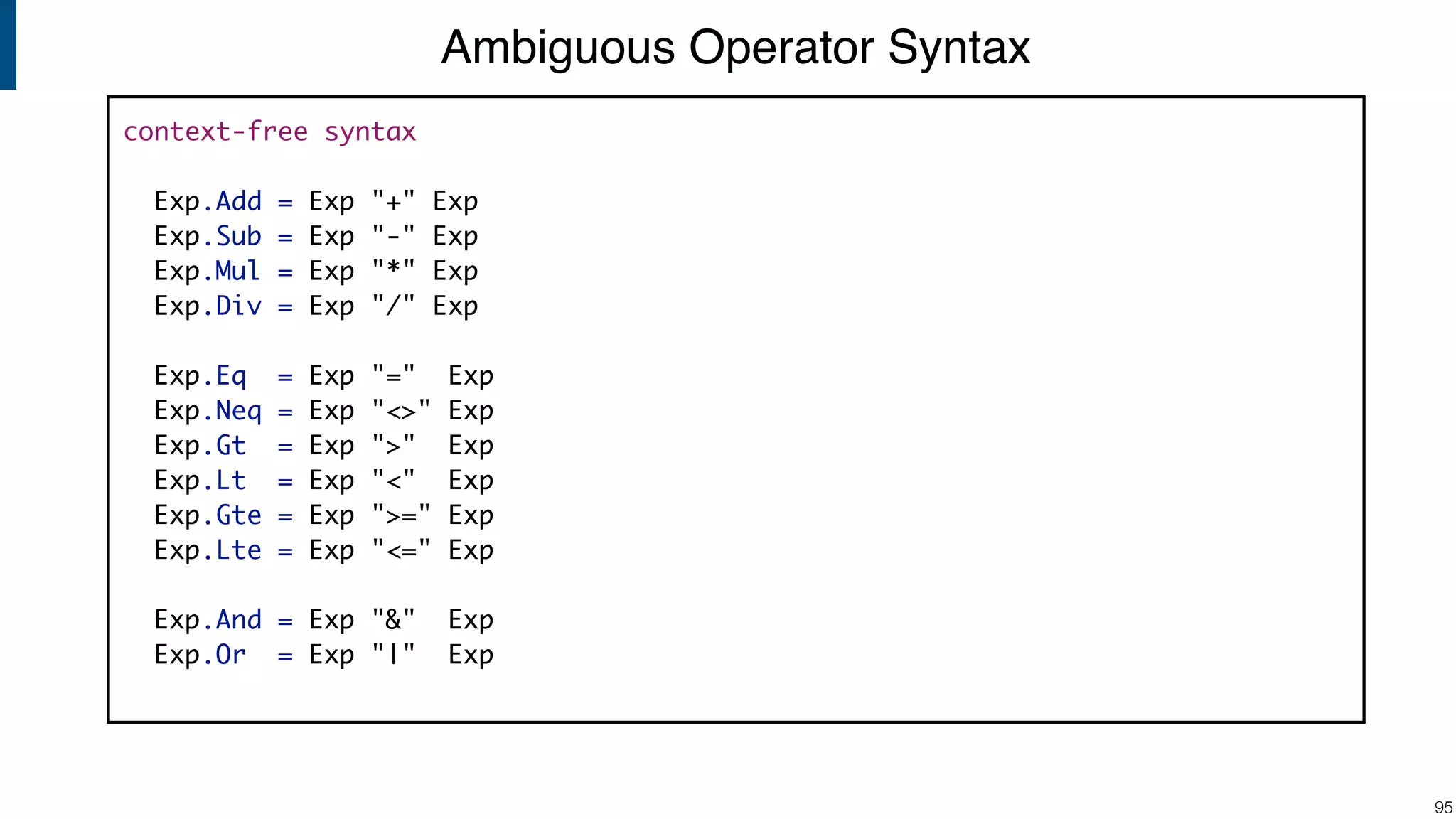
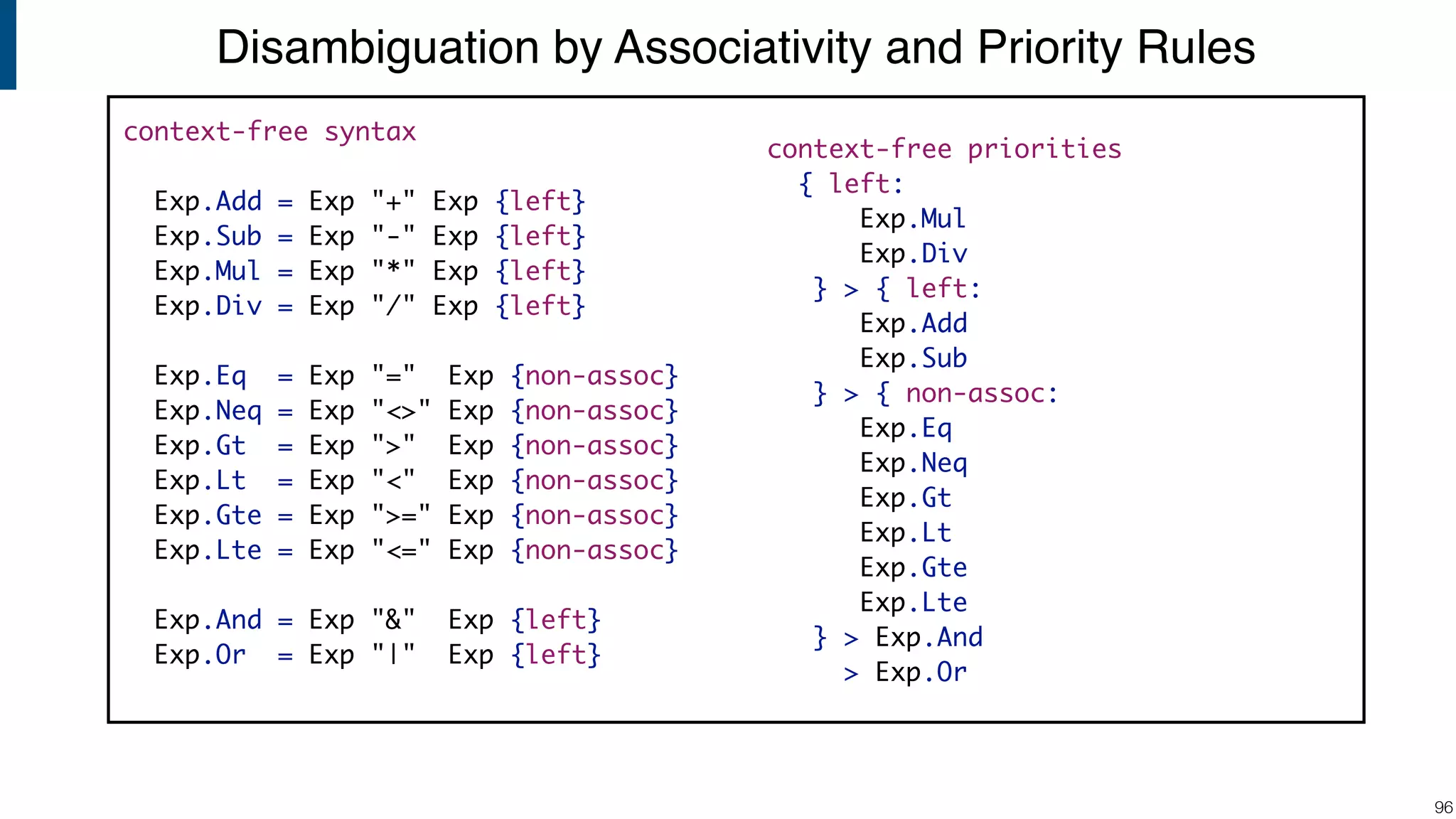
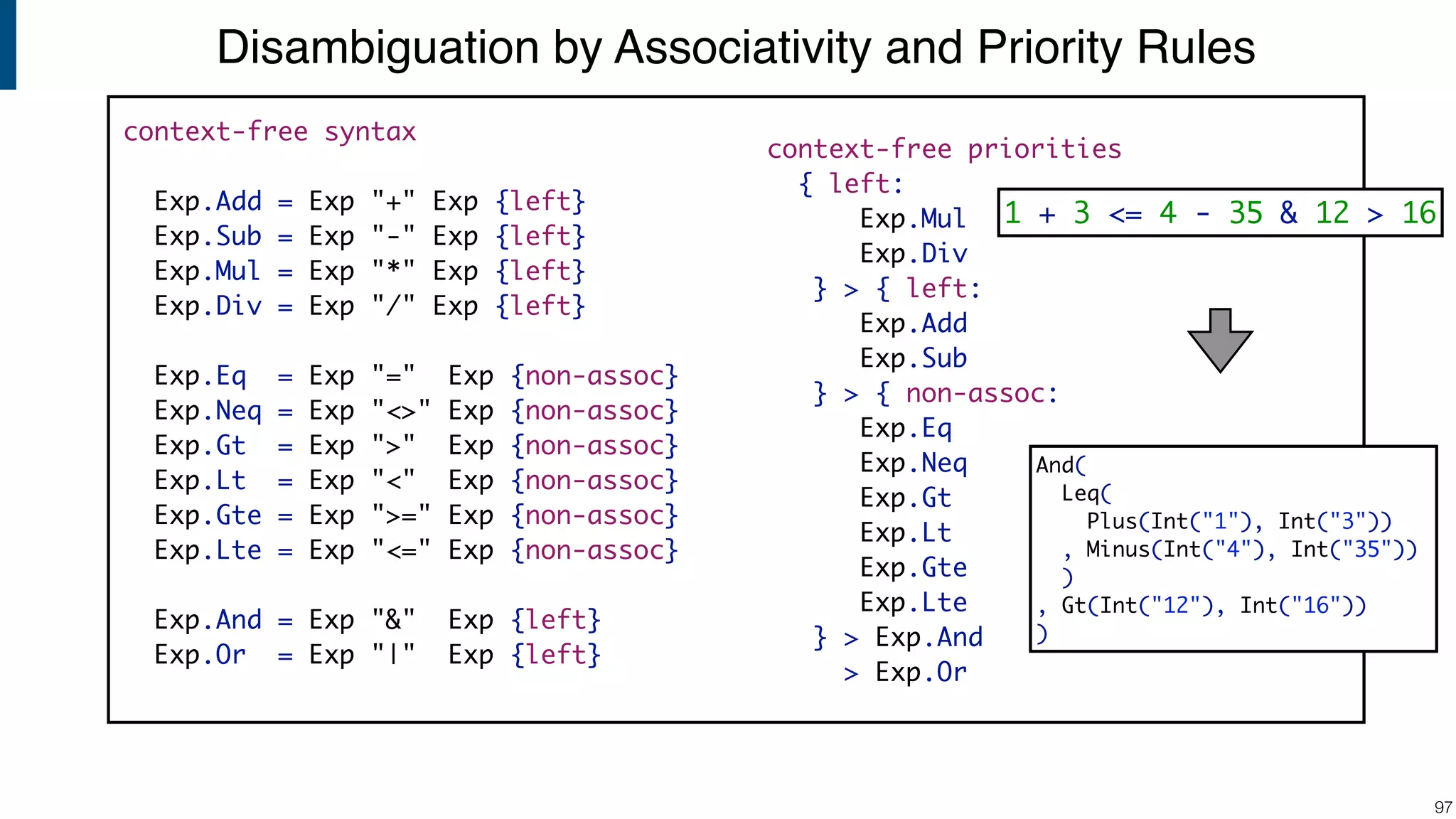
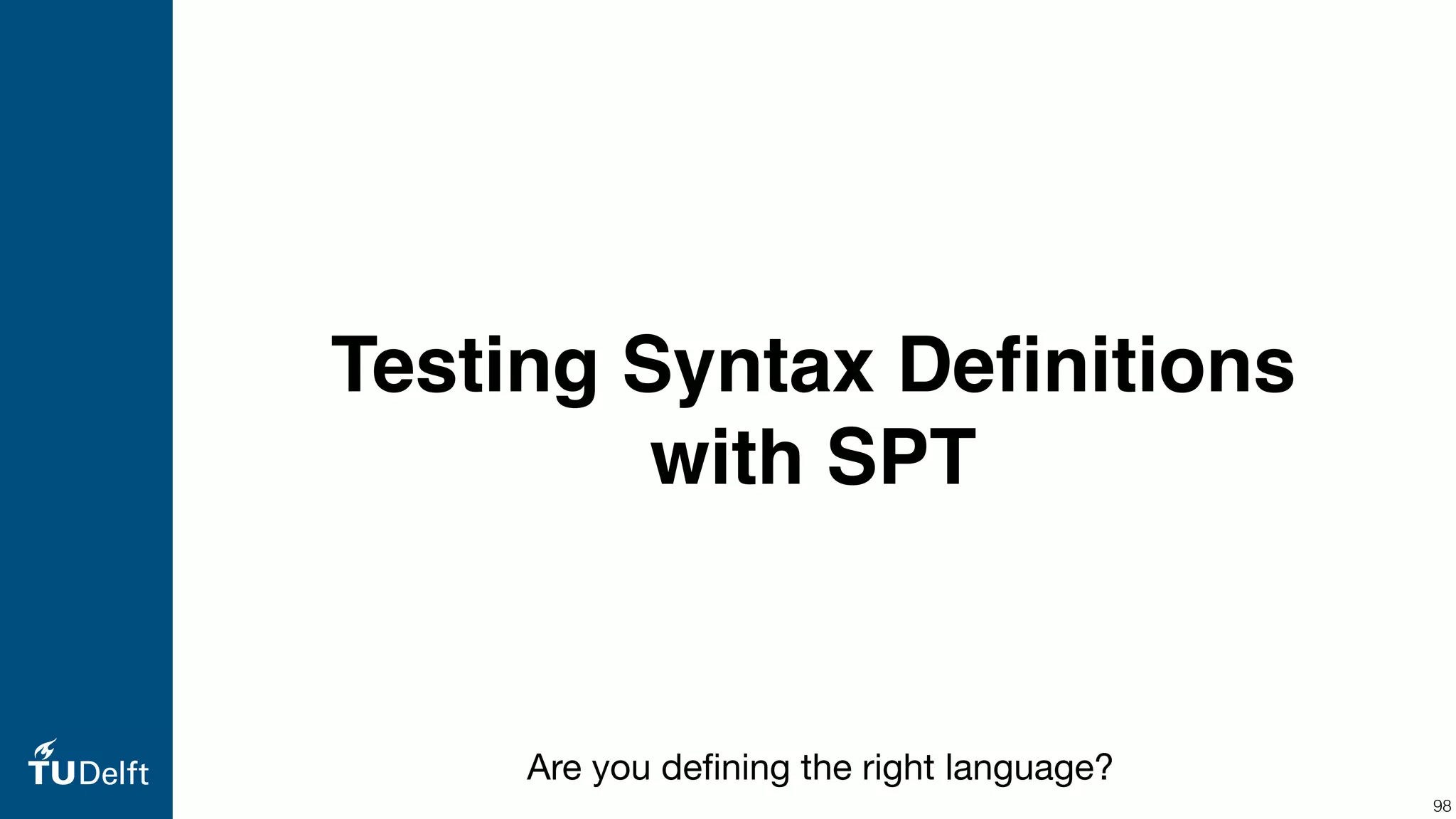
![Test Suites !99 module example-suite language Tiger start symbol Start test name [[...]] parse succeeds test another name [[...]] parse fails SPT: SPoofax Testing language](https://image.slidesharecdn.com/cs4200-2018-2-syntax-definition-180907135337/75/Compiler-Construction-Lecture-2-Declarative-Syntax-Definition-99-2048.jpg)
![Success is Failure, Failure is Success, … !100 module success-failure language Tiger test this test succeeds [[ 1 + 3 * 4 ]] parse succeeds test this test fails [[ 1 + 3 * 4 ]] parse fails test this test fails [[ 1 + 3 * ]] parse succeeds test this test succeeds [[ 1 + 3 * ]] parse fails](https://image.slidesharecdn.com/cs4200-2018-2-syntax-definition-180907135337/75/Compiler-Construction-Lecture-2-Declarative-Syntax-Definition-100-2048.jpg)
![Test Cases: Valid !101 Language valid program test valid program [[...]] parse succeeds](https://image.slidesharecdn.com/cs4200-2018-2-syntax-definition-180907135337/75/Compiler-Construction-Lecture-2-Declarative-Syntax-Definition-101-2048.jpg)
![Test Cases: Invalid !102 test invalid program [[...]] parse fails invalid program Language](https://image.slidesharecdn.com/cs4200-2018-2-syntax-definition-180907135337/75/Compiler-Construction-Lecture-2-Declarative-Syntax-Definition-102-2048.jpg)
![Test Cases !103 module syntax/identifiers language Tiger start symbol Id test single lower case [[x]] parse succeeds test single upper case [[X]] parse succeeds test single digit [[1]] parse fails test single lc digit [[x1]] parse succeeds test single digit lc [[1x]] parse fails test single uc digit [[X1]] parse succeeds test single digit uc [[1X]] parse fails test double digit [[11]] parse fails](https://image.slidesharecdn.com/cs4200-2018-2-syntax-definition-180907135337/75/Compiler-Construction-Lecture-2-Declarative-Syntax-Definition-103-2048.jpg)
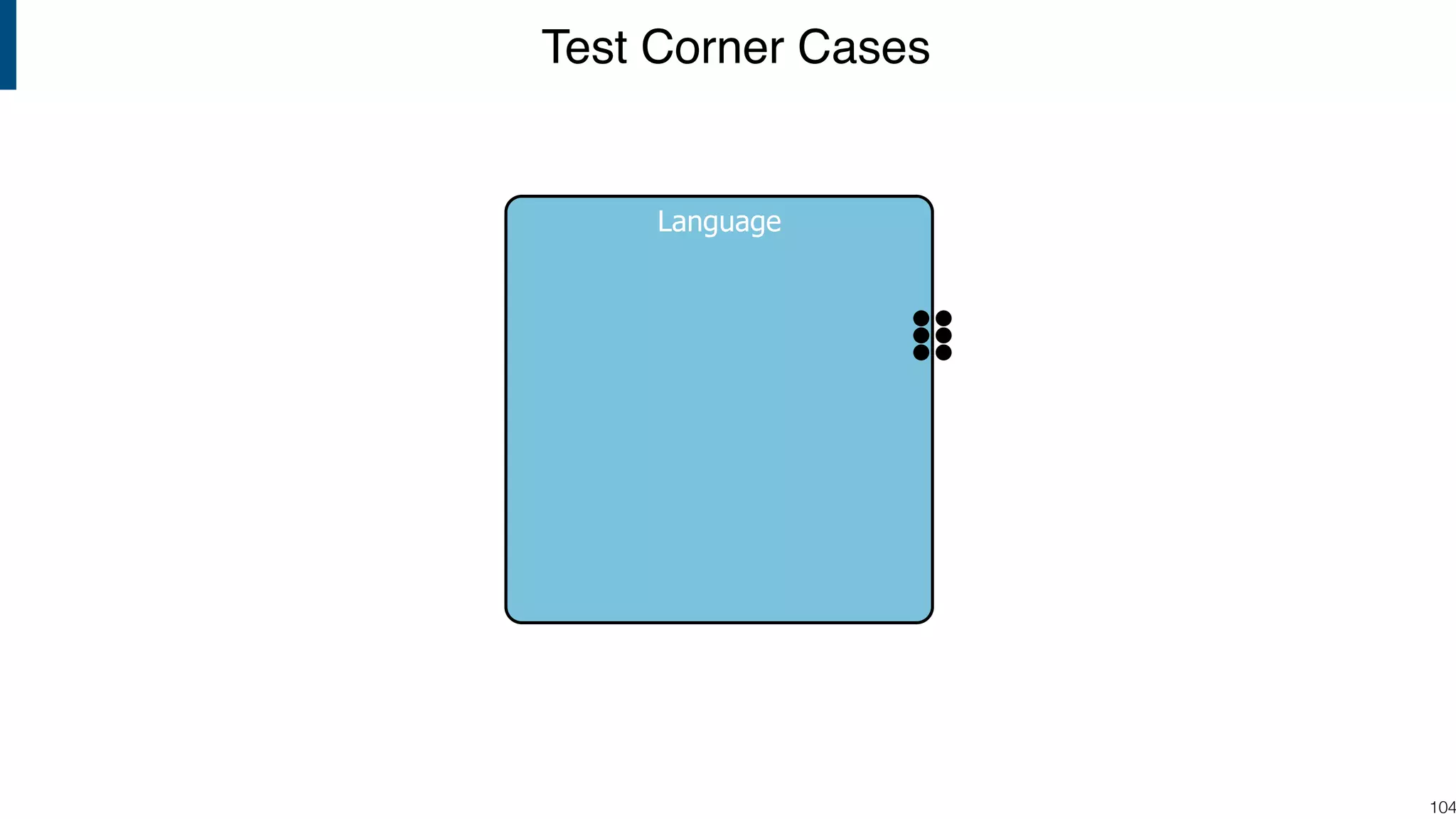
![Testing Structure !105 module structure language Tiger test add times [[ 21 + 14 + 7 ]] parse to Mod(Plus(Int(“21"),Times(Int("14"),Int("7")))) test times add [[ 3 * 7 + 21 ]] parse to Mod(Plus(Times(Int(“3"),Int("7")),Int("21"))) test if [[ if x then 3 else 4 ]] parse to Mod(If(Var("x"),Int("3"),Int("4"))) The fragment did not parse to the expected ATerm. Parse result was: Mod(Plus(Plus(Int("21"),Int("14")),Int("7"))) Expected result was: Mod(Plus(Int(21), Times(Int(14), Int(7))))](https://image.slidesharecdn.com/cs4200-2018-2-syntax-definition-180907135337/75/Compiler-Construction-Lecture-2-Declarative-Syntax-Definition-105-2048.jpg)
![Testing Ambiguity !106 Note : this does not actually work in Tiger, since () is a sequencing construct; but works fine in Mini-Java module precedence language Tiger start symbol Exp test parentheses [[(42)]] parse to [[42]] test left-associative addition [[21 + 14 + 7]] parse to [[(21 + 14) + 7]] test precedence multiplication [[3 * 7 + 21]] parse to [[(3 * 7) + 21]]](https://image.slidesharecdn.com/cs4200-2018-2-syntax-definition-180907135337/75/Compiler-Construction-Lecture-2-Declarative-Syntax-Definition-106-2048.jpg)
![Testing Ambiguity !107 module precedence language Tiger start symbol Exp test plus/times priority [[ x + 4 * 5 ]] parse to Plus(Var("x"), Times(Int("4"), Int("5"))) test plus/times sequence [[ (x + 4) * 5 ]] parse to Times( Seq([Plus(Var("x"), Int("4"))]) , Int("5") )](https://image.slidesharecdn.com/cs4200-2018-2-syntax-definition-180907135337/75/Compiler-Construction-Lecture-2-Declarative-Syntax-Definition-107-2048.jpg)
